Teaching Plans for Children: Engaging Activities for Learning and Development
VerifiedAdded on 2023/06/09
|24
|5306
|445
AI Summary
This set of teaching plans for children includes engaging activities for learning and development. The plans cover topics like alphabets, counting, building blocks, fruits, and more. Each plan has specific objectives, rationale, learning outcomes, materials and resources, preparation steps, and evaluation. The plans are designed to make learning fun and interactive for children.
Contribute Materials
Your contribution can guide someone’s learning journey. Share your
documents today.
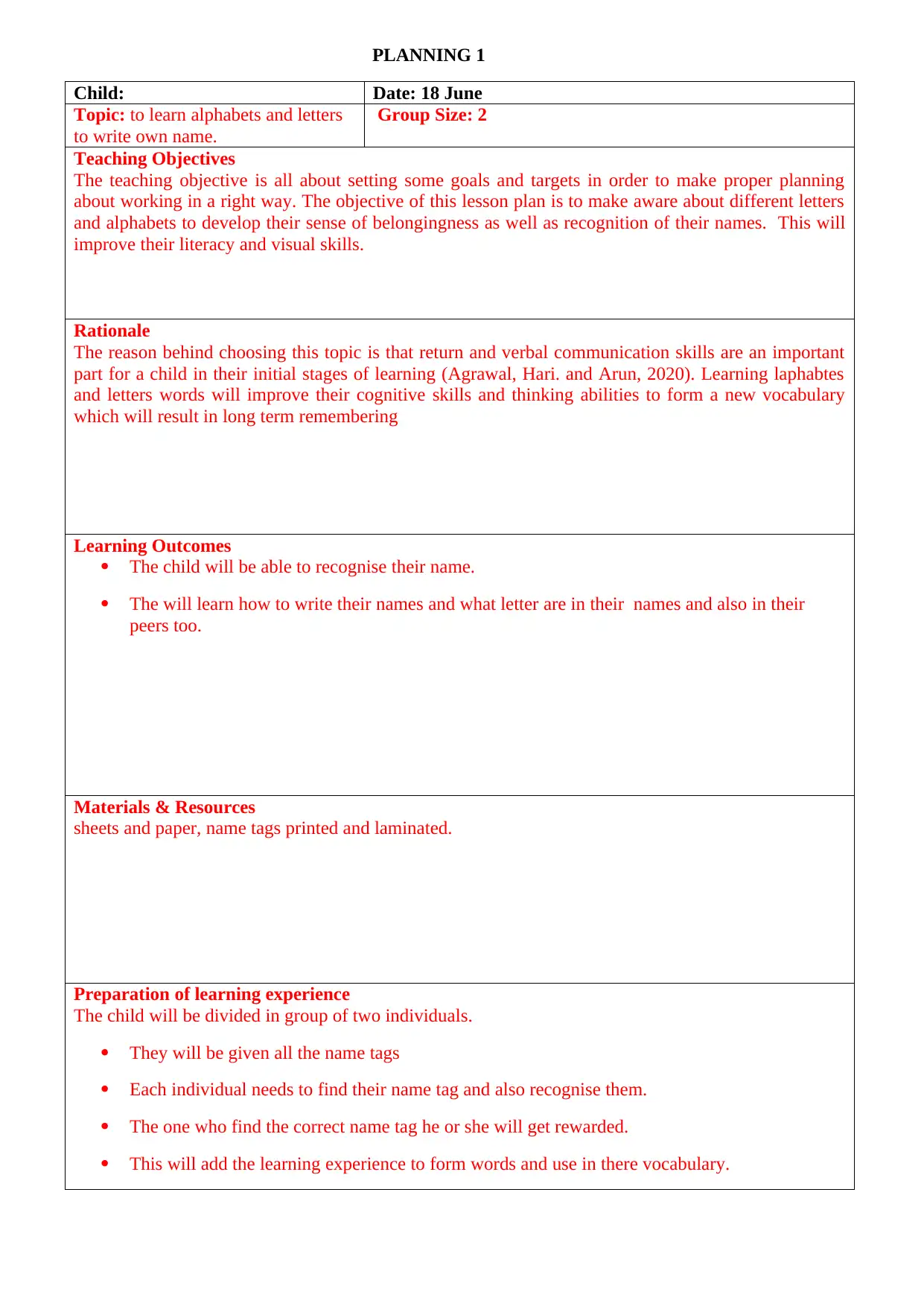
PLANNING 1
Child: Date: 18 June
Topic: to learn alphabets and letters
to write own name.
Group Size: 2
Teaching Objectives
The teaching objective is all about setting some goals and targets in order to make proper planning
about working in a right way. The objective of this lesson plan is to make aware about different letters
and alphabets to develop their sense of belongingness as well as recognition of their names. This will
improve their literacy and visual skills.
Rationale
The reason behind choosing this topic is that return and verbal communication skills are an important
part for a child in their initial stages of learning (Agrawal, Hari. and Arun, 2020). Learning laphabtes
and letters words will improve their cognitive skills and thinking abilities to form a new vocabulary
which will result in long term remembering
Learning Outcomes
The child will be able to recognise their name.
The will learn how to write their names and what letter are in their names and also in their
peers too.
Materials & Resources
sheets and paper, name tags printed and laminated.
Preparation of learning experience
The child will be divided in group of two individuals.
They will be given all the name tags
Each individual needs to find their name tag and also recognise them.
The one who find the correct name tag he or she will get rewarded.
This will add the learning experience to form words and use in there vocabulary.
Child: Date: 18 June
Topic: to learn alphabets and letters
to write own name.
Group Size: 2
Teaching Objectives
The teaching objective is all about setting some goals and targets in order to make proper planning
about working in a right way. The objective of this lesson plan is to make aware about different letters
and alphabets to develop their sense of belongingness as well as recognition of their names. This will
improve their literacy and visual skills.
Rationale
The reason behind choosing this topic is that return and verbal communication skills are an important
part for a child in their initial stages of learning (Agrawal, Hari. and Arun, 2020). Learning laphabtes
and letters words will improve their cognitive skills and thinking abilities to form a new vocabulary
which will result in long term remembering
Learning Outcomes
The child will be able to recognise their name.
The will learn how to write their names and what letter are in their names and also in their
peers too.
Materials & Resources
sheets and paper, name tags printed and laminated.
Preparation of learning experience
The child will be divided in group of two individuals.
They will be given all the name tags
Each individual needs to find their name tag and also recognise them.
The one who find the correct name tag he or she will get rewarded.
This will add the learning experience to form words and use in there vocabulary.
Secure Best Marks with AI Grader
Need help grading? Try our AI Grader for instant feedback on your assignments.
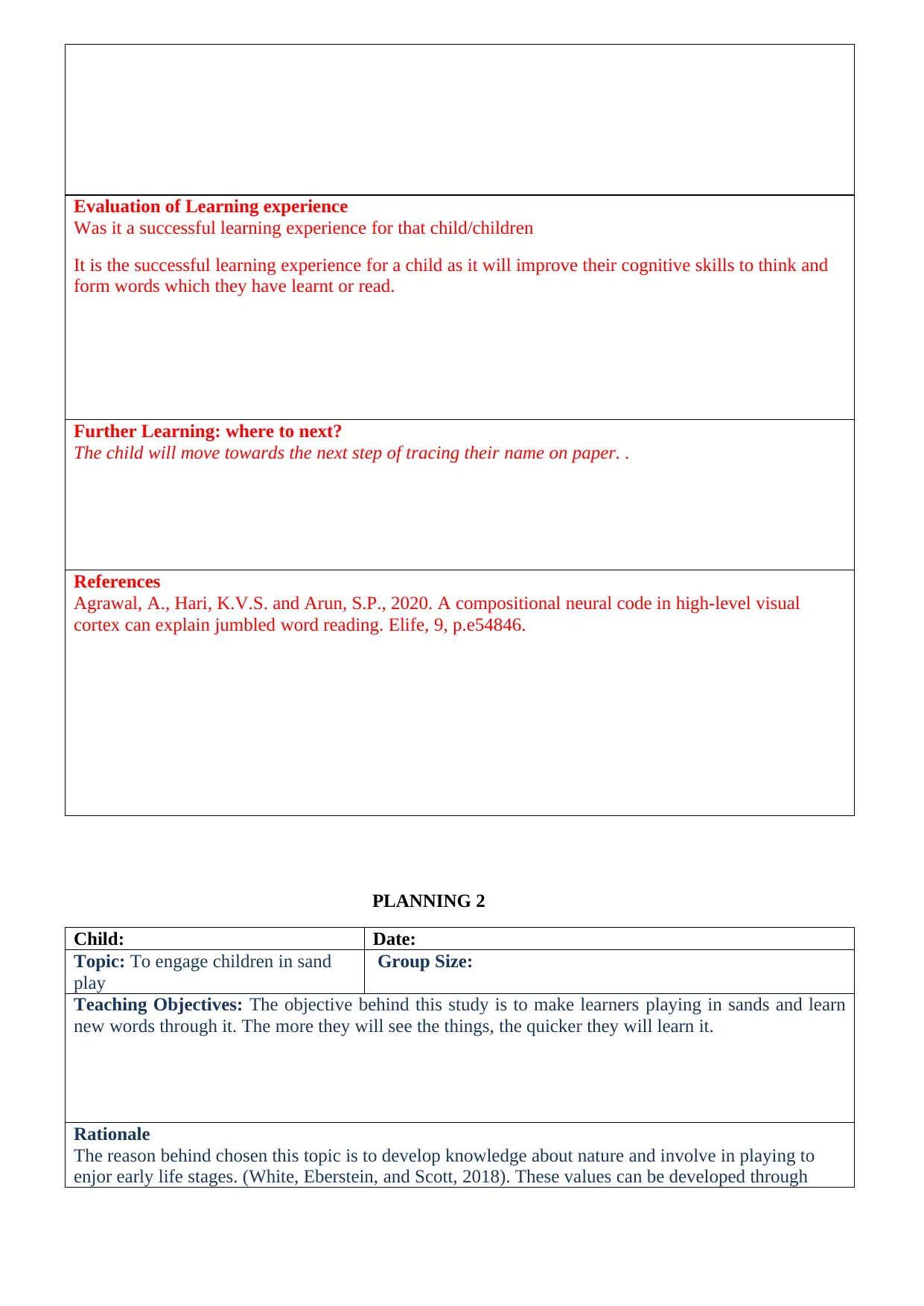
Evaluation of Learning experience
Was it a successful learning experience for that child/children
It is the successful learning experience for a child as it will improve their cognitive skills to think and
form words which they have learnt or read.
Further Learning: where to next?
The child will move towards the next step of tracing their name on paper. .
References
Agrawal, A., Hari, K.V.S. and Arun, S.P., 2020. A compositional neural code in high-level visual
cortex can explain jumbled word reading. Elife, 9, p.e54846.
PLANNING 2
Child: Date:
Topic: To engage children in sand
play
Group Size:
Teaching Objectives: The objective behind this study is to make learners playing in sands and learn
new words through it. The more they will see the things, the quicker they will learn it.
Rationale
The reason behind chosen this topic is to develop knowledge about nature and involve in playing to
enjor early life stages. (White, Eberstein, and Scott, 2018). These values can be developed through
Was it a successful learning experience for that child/children
It is the successful learning experience for a child as it will improve their cognitive skills to think and
form words which they have learnt or read.
Further Learning: where to next?
The child will move towards the next step of tracing their name on paper. .
References
Agrawal, A., Hari, K.V.S. and Arun, S.P., 2020. A compositional neural code in high-level visual
cortex can explain jumbled word reading. Elife, 9, p.e54846.
PLANNING 2
Child: Date:
Topic: To engage children in sand
play
Group Size:
Teaching Objectives: The objective behind this study is to make learners playing in sands and learn
new words through it. The more they will see the things, the quicker they will learn it.
Rationale
The reason behind chosen this topic is to develop knowledge about nature and involve in playing to
enjor early life stages. (White, Eberstein, and Scott, 2018). These values can be developed through
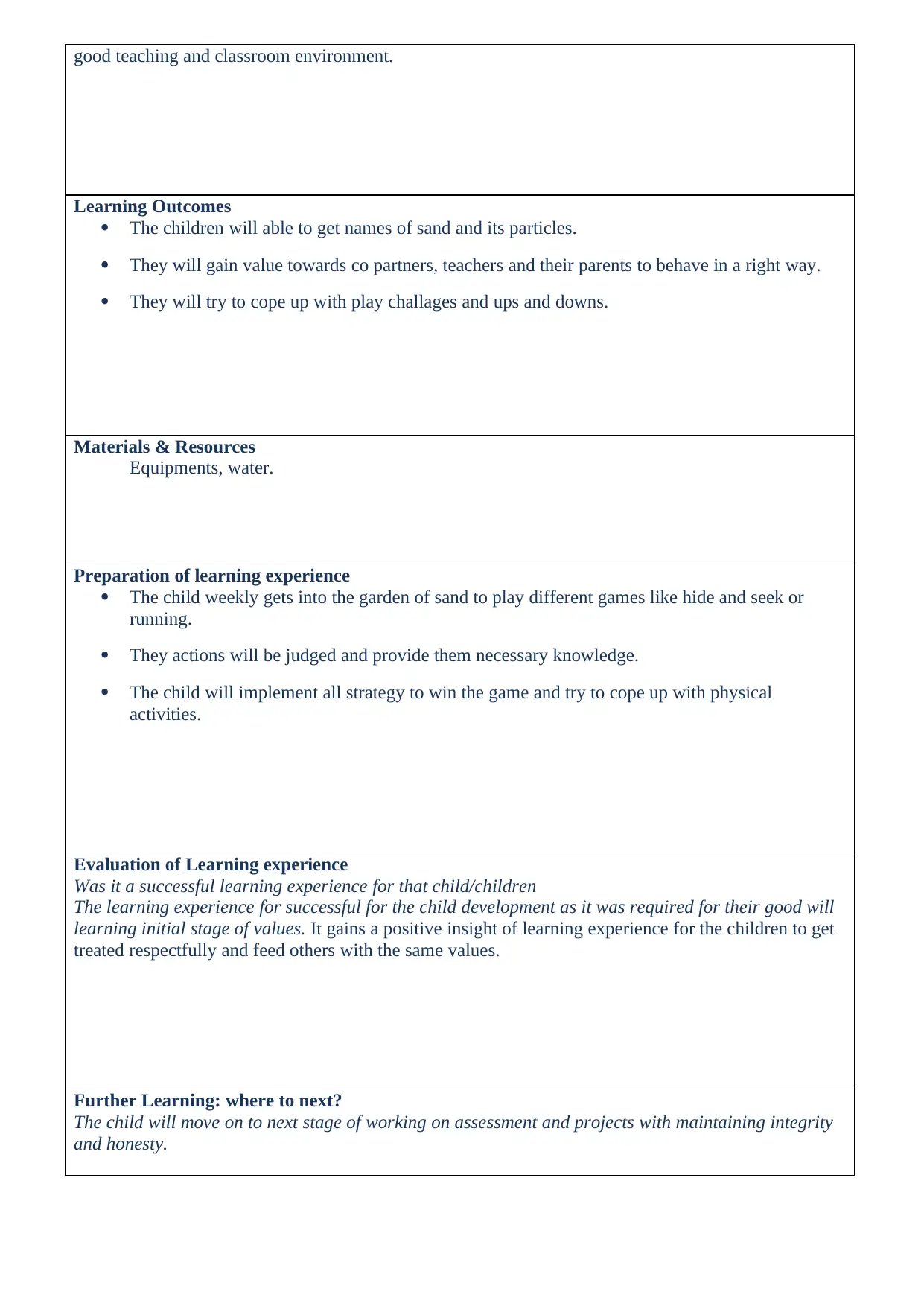
good teaching and classroom environment.
Learning Outcomes
The children will able to get names of sand and its particles.
They will gain value towards co partners, teachers and their parents to behave in a right way.
They will try to cope up with play challages and ups and downs.
Materials & Resources
Equipments, water.
Preparation of learning experience
The child weekly gets into the garden of sand to play different games like hide and seek or
running.
They actions will be judged and provide them necessary knowledge.
The child will implement all strategy to win the game and try to cope up with physical
activities.
Evaluation of Learning experience
Was it a successful learning experience for that child/children
The learning experience for successful for the child development as it was required for their good will
learning initial stage of values. It gains a positive insight of learning experience for the children to get
treated respectfully and feed others with the same values.
Further Learning: where to next?
The child will move on to next stage of working on assessment and projects with maintaining integrity
and honesty.
Learning Outcomes
The children will able to get names of sand and its particles.
They will gain value towards co partners, teachers and their parents to behave in a right way.
They will try to cope up with play challages and ups and downs.
Materials & Resources
Equipments, water.
Preparation of learning experience
The child weekly gets into the garden of sand to play different games like hide and seek or
running.
They actions will be judged and provide them necessary knowledge.
The child will implement all strategy to win the game and try to cope up with physical
activities.
Evaluation of Learning experience
Was it a successful learning experience for that child/children
The learning experience for successful for the child development as it was required for their good will
learning initial stage of values. It gains a positive insight of learning experience for the children to get
treated respectfully and feed others with the same values.
Further Learning: where to next?
The child will move on to next stage of working on assessment and projects with maintaining integrity
and honesty.
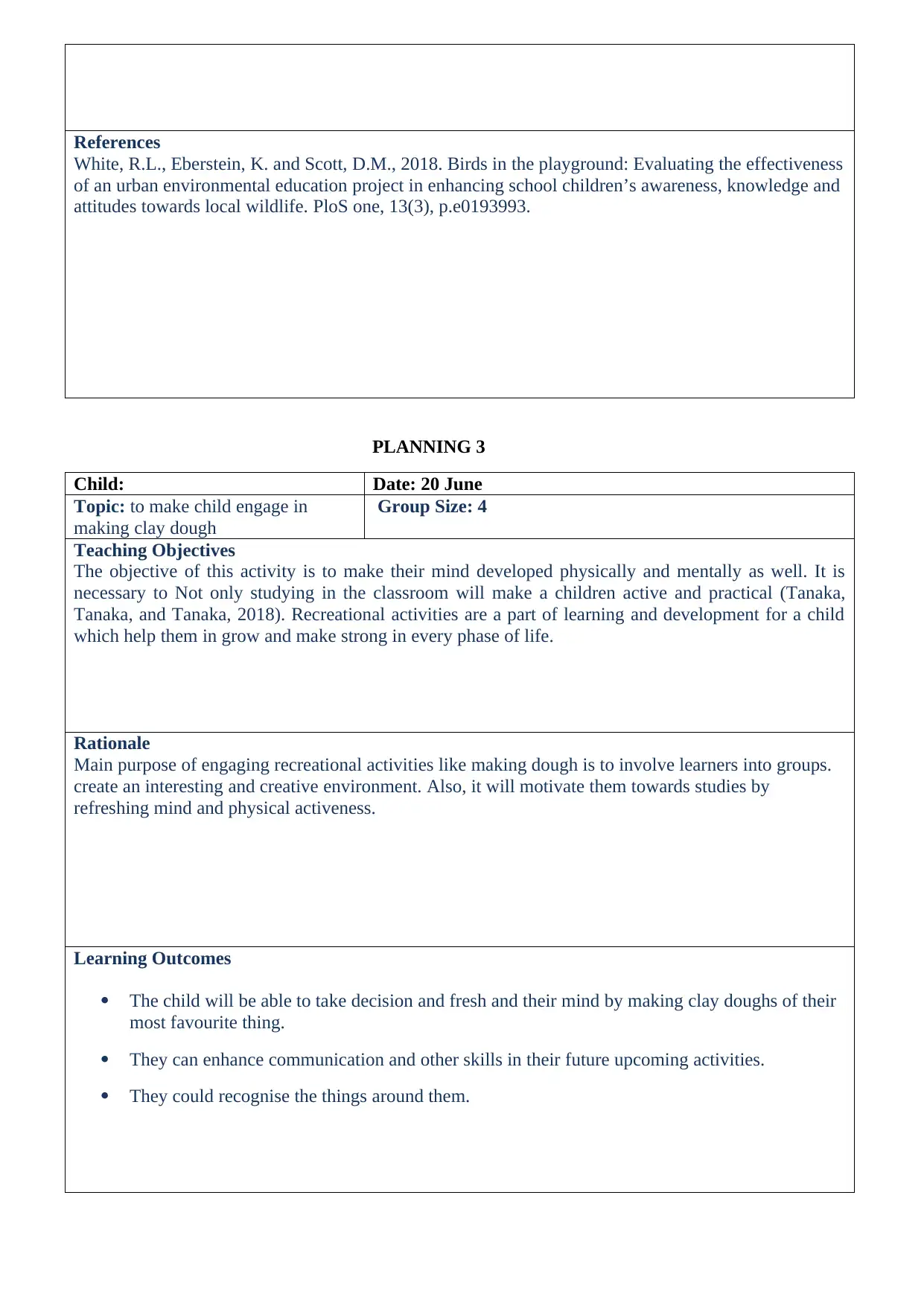
References
White, R.L., Eberstein, K. and Scott, D.M., 2018. Birds in the playground: Evaluating the effectiveness
of an urban environmental education project in enhancing school children’s awareness, knowledge and
attitudes towards local wildlife. PloS one, 13(3), p.e0193993.
PLANNING 3
Child: Date: 20 June
Topic: to make child engage in
making clay dough
Group Size: 4
Teaching Objectives
The objective of this activity is to make their mind developed physically and mentally as well. It is
necessary to Not only studying in the classroom will make a children active and practical (Tanaka,
Tanaka, and Tanaka, 2018). Recreational activities are a part of learning and development for a child
which help them in grow and make strong in every phase of life.
Rationale
Main purpose of engaging recreational activities like making dough is to involve learners into groups.
create an interesting and creative environment. Also, it will motivate them towards studies by
refreshing mind and physical activeness.
Learning Outcomes
The child will be able to take decision and fresh and their mind by making clay doughs of their
most favourite thing.
They can enhance communication and other skills in their future upcoming activities.
They could recognise the things around them.
White, R.L., Eberstein, K. and Scott, D.M., 2018. Birds in the playground: Evaluating the effectiveness
of an urban environmental education project in enhancing school children’s awareness, knowledge and
attitudes towards local wildlife. PloS one, 13(3), p.e0193993.
PLANNING 3
Child: Date: 20 June
Topic: to make child engage in
making clay dough
Group Size: 4
Teaching Objectives
The objective of this activity is to make their mind developed physically and mentally as well. It is
necessary to Not only studying in the classroom will make a children active and practical (Tanaka,
Tanaka, and Tanaka, 2018). Recreational activities are a part of learning and development for a child
which help them in grow and make strong in every phase of life.
Rationale
Main purpose of engaging recreational activities like making dough is to involve learners into groups.
create an interesting and creative environment. Also, it will motivate them towards studies by
refreshing mind and physical activeness.
Learning Outcomes
The child will be able to take decision and fresh and their mind by making clay doughs of their
most favourite thing.
They can enhance communication and other skills in their future upcoming activities.
They could recognise the things around them.
Secure Best Marks with AI Grader
Need help grading? Try our AI Grader for instant feedback on your assignments.
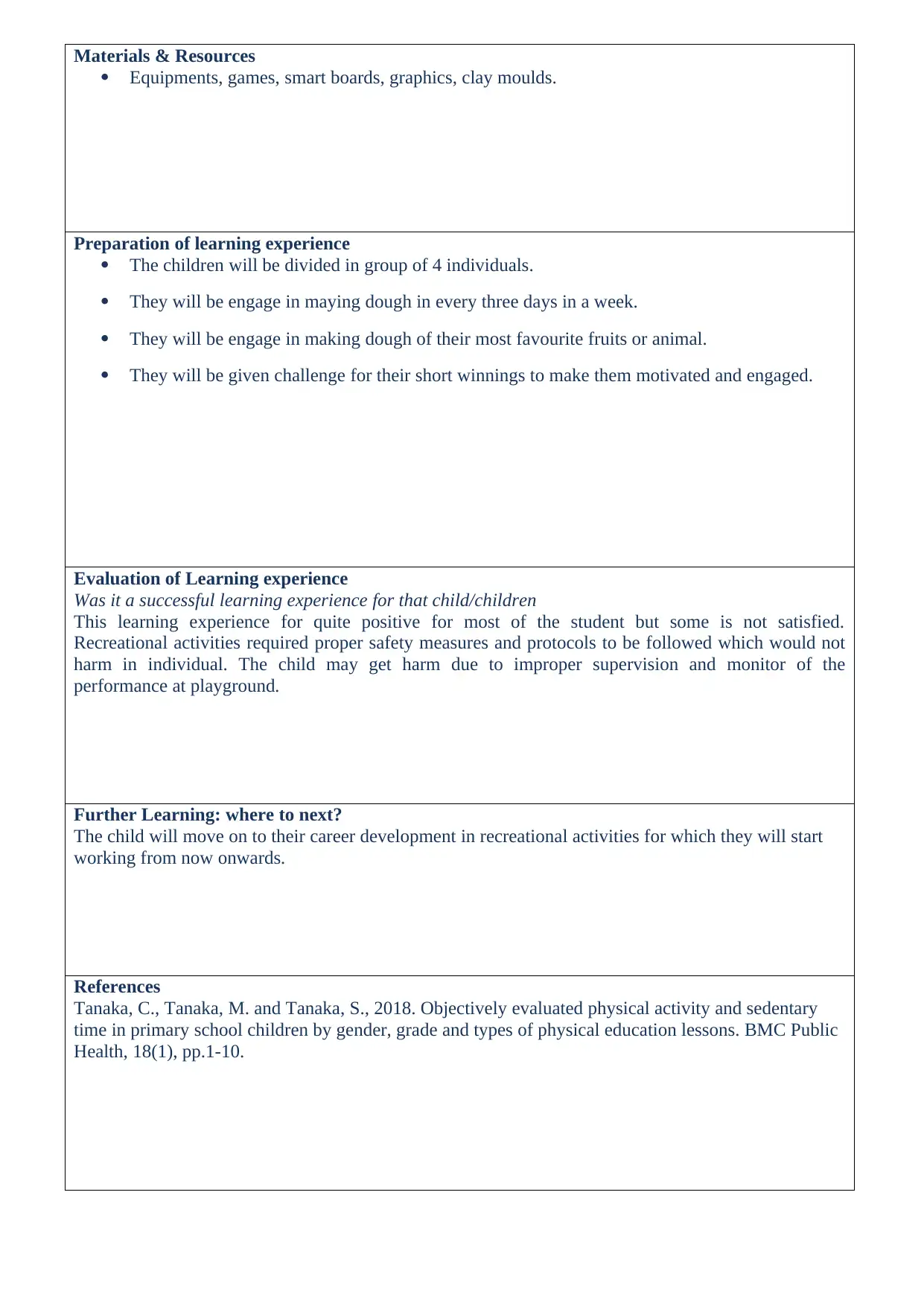
Materials & Resources
Equipments, games, smart boards, graphics, clay moulds.
Preparation of learning experience
The children will be divided in group of 4 individuals.
They will be engage in maying dough in every three days in a week.
They will be engage in making dough of their most favourite fruits or animal.
They will be given challenge for their short winnings to make them motivated and engaged.
Evaluation of Learning experience
Was it a successful learning experience for that child/children
This learning experience for quite positive for most of the student but some is not satisfied.
Recreational activities required proper safety measures and protocols to be followed which would not
harm in individual. The child may get harm due to improper supervision and monitor of the
performance at playground.
Further Learning: where to next?
The child will move on to their career development in recreational activities for which they will start
working from now onwards.
References
Tanaka, C., Tanaka, M. and Tanaka, S., 2018. Objectively evaluated physical activity and sedentary
time in primary school children by gender, grade and types of physical education lessons. BMC Public
Health, 18(1), pp.1-10.
Equipments, games, smart boards, graphics, clay moulds.
Preparation of learning experience
The children will be divided in group of 4 individuals.
They will be engage in maying dough in every three days in a week.
They will be engage in making dough of their most favourite fruits or animal.
They will be given challenge for their short winnings to make them motivated and engaged.
Evaluation of Learning experience
Was it a successful learning experience for that child/children
This learning experience for quite positive for most of the student but some is not satisfied.
Recreational activities required proper safety measures and protocols to be followed which would not
harm in individual. The child may get harm due to improper supervision and monitor of the
performance at playground.
Further Learning: where to next?
The child will move on to their career development in recreational activities for which they will start
working from now onwards.
References
Tanaka, C., Tanaka, M. and Tanaka, S., 2018. Objectively evaluated physical activity and sedentary
time in primary school children by gender, grade and types of physical education lessons. BMC Public
Health, 18(1), pp.1-10.

PLANNING 4
Child: Date:
Topic: To make children tracing
their names of paper.
Group Size:
Teaching Objectives
The objective for involving children in To make children tracing their names of paper. Cognitive
development tracing their names within set time. Therefore objective is to learn their knowledge ability
to recognise their names.
Rationale
The reason behind using this topic is to fulfil teaching criteria and make them learn about how to write
letters and words. (Kosmas, Ioannou, and Zaphiris, 2019). The name tracing will help teach children to
think from all the corners and sides before learning difficult words.
Learning Outcomes
The children will trace the name
The child will be able to demonstrate their name and will try to speak it out louder.
They will be able to feel confident.
Materials & Resources
It requires quizzes blackboards smart boards presentation, question booklet.
Preparation of learning experience
The child will engage individually tracing names.
They need to solve other peers tracing names
The children will show case cognitive skills by tracing names within 1 minute.
Child: Date:
Topic: To make children tracing
their names of paper.
Group Size:
Teaching Objectives
The objective for involving children in To make children tracing their names of paper. Cognitive
development tracing their names within set time. Therefore objective is to learn their knowledge ability
to recognise their names.
Rationale
The reason behind using this topic is to fulfil teaching criteria and make them learn about how to write
letters and words. (Kosmas, Ioannou, and Zaphiris, 2019). The name tracing will help teach children to
think from all the corners and sides before learning difficult words.
Learning Outcomes
The children will trace the name
The child will be able to demonstrate their name and will try to speak it out louder.
They will be able to feel confident.
Materials & Resources
It requires quizzes blackboards smart boards presentation, question booklet.
Preparation of learning experience
The child will engage individually tracing names.
They need to solve other peers tracing names
The children will show case cognitive skills by tracing names within 1 minute.
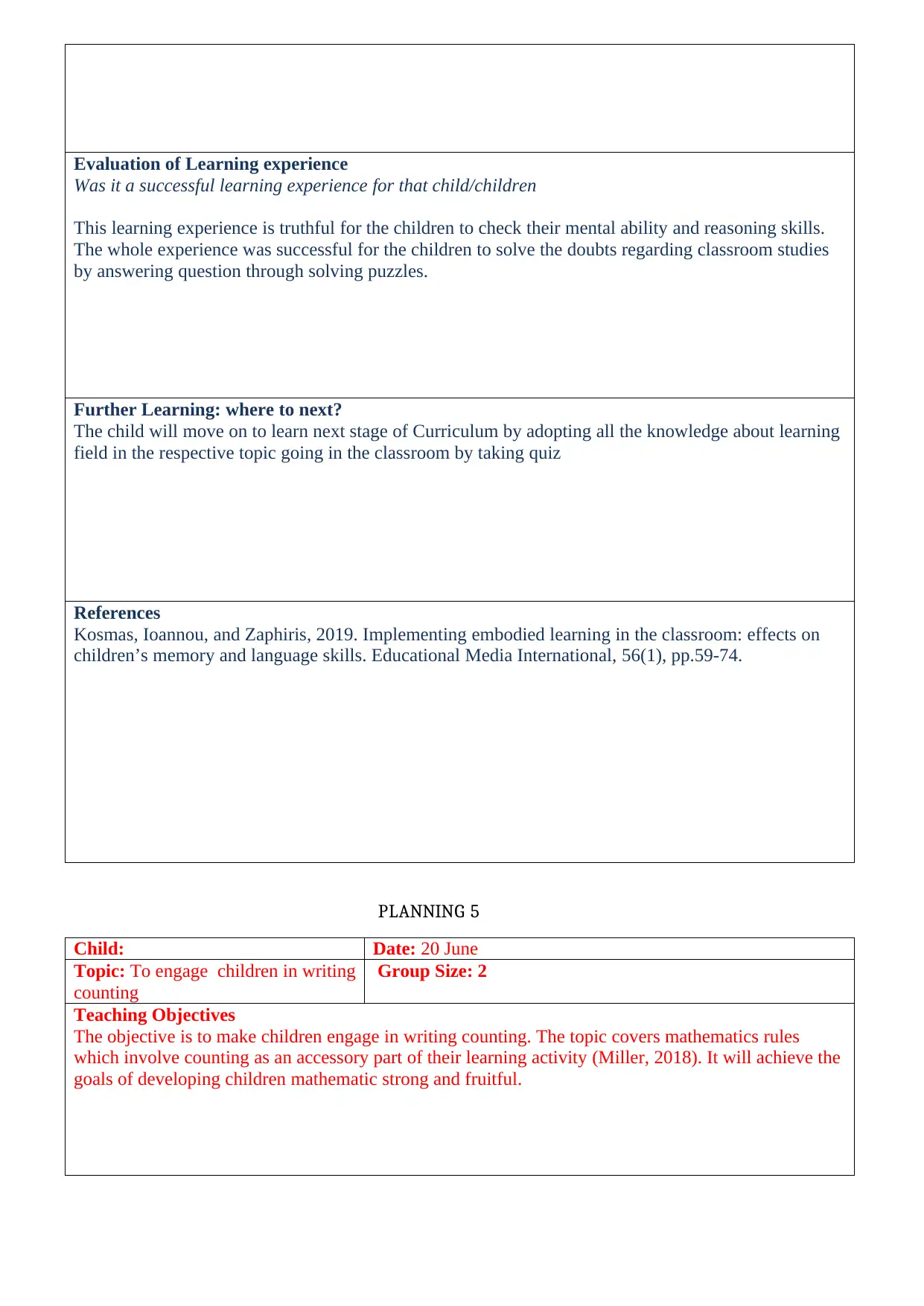
Evaluation of Learning experience
Was it a successful learning experience for that child/children
This learning experience is truthful for the children to check their mental ability and reasoning skills.
The whole experience was successful for the children to solve the doubts regarding classroom studies
by answering question through solving puzzles.
Further Learning: where to next?
The child will move on to learn next stage of Curriculum by adopting all the knowledge about learning
field in the respective topic going in the classroom by taking quiz
References
Kosmas, Ioannou, and Zaphiris, 2019. Implementing embodied learning in the classroom: effects on
children’s memory and language skills. Educational Media International, 56(1), pp.59-74.
PLANNING 5
Child: Date: 20 June
Topic: To engage children in writing
counting
Group Size: 2
Teaching Objectives
The objective is to make children engage in writing counting. The topic covers mathematics rules
which involve counting as an accessory part of their learning activity (Miller, 2018). It will achieve the
goals of developing children mathematic strong and fruitful.
Was it a successful learning experience for that child/children
This learning experience is truthful for the children to check their mental ability and reasoning skills.
The whole experience was successful for the children to solve the doubts regarding classroom studies
by answering question through solving puzzles.
Further Learning: where to next?
The child will move on to learn next stage of Curriculum by adopting all the knowledge about learning
field in the respective topic going in the classroom by taking quiz
References
Kosmas, Ioannou, and Zaphiris, 2019. Implementing embodied learning in the classroom: effects on
children’s memory and language skills. Educational Media International, 56(1), pp.59-74.
PLANNING 5
Child: Date: 20 June
Topic: To engage children in writing
counting
Group Size: 2
Teaching Objectives
The objective is to make children engage in writing counting. The topic covers mathematics rules
which involve counting as an accessory part of their learning activity (Miller, 2018). It will achieve the
goals of developing children mathematic strong and fruitful.
Paraphrase This Document
Need a fresh take? Get an instant paraphrase of this document with our AI Paraphraser
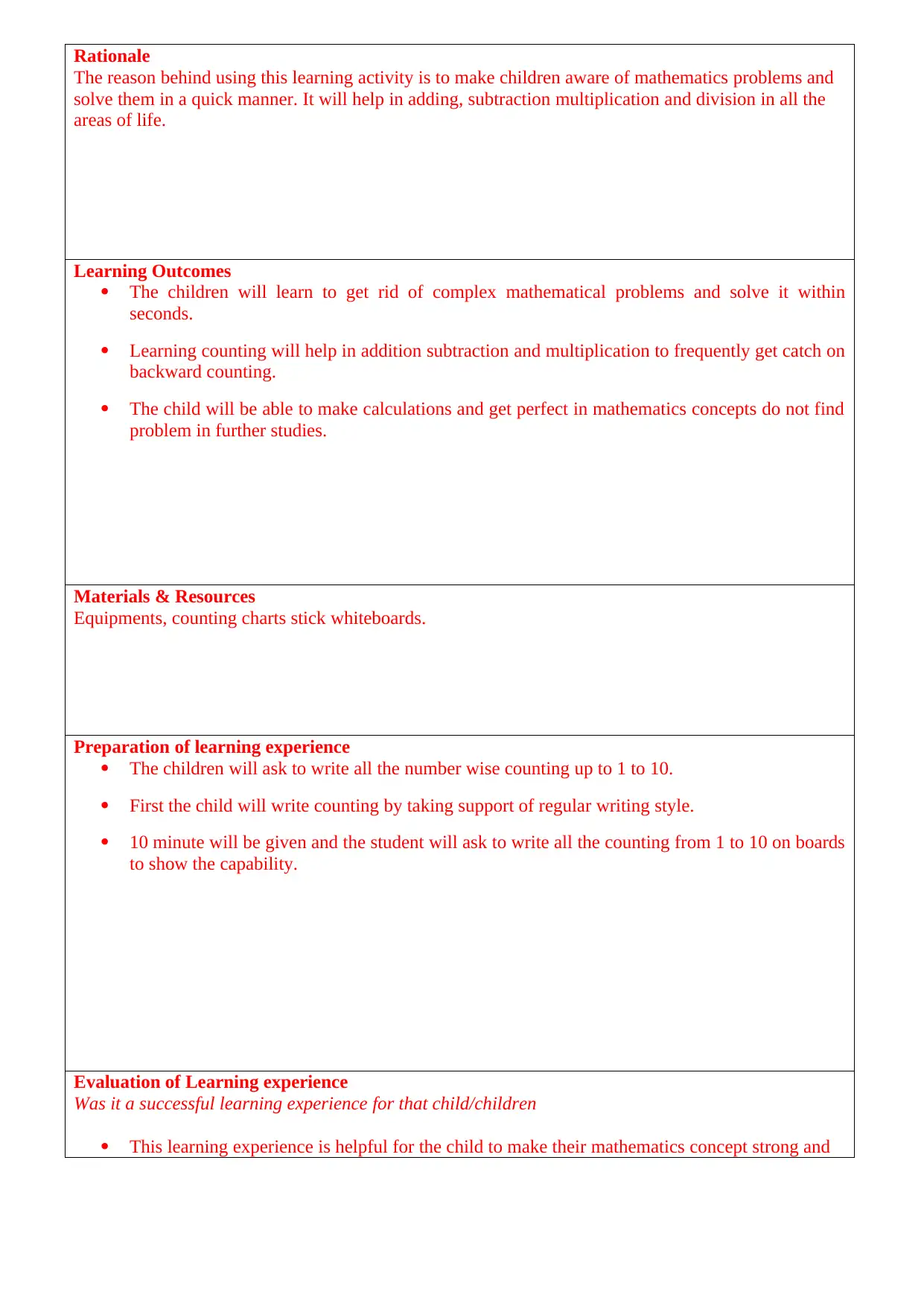
Rationale
The reason behind using this learning activity is to make children aware of mathematics problems and
solve them in a quick manner. It will help in adding, subtraction multiplication and division in all the
areas of life.
Learning Outcomes
The children will learn to get rid of complex mathematical problems and solve it within
seconds.
Learning counting will help in addition subtraction and multiplication to frequently get catch on
backward counting.
The child will be able to make calculations and get perfect in mathematics concepts do not find
problem in further studies.
Materials & Resources
Equipments, counting charts stick whiteboards.
Preparation of learning experience
The children will ask to write all the number wise counting up to 1 to 10.
First the child will write counting by taking support of regular writing style.
10 minute will be given and the student will ask to write all the counting from 1 to 10 on boards
to show the capability.
Evaluation of Learning experience
Was it a successful learning experience for that child/children
This learning experience is helpful for the child to make their mathematics concept strong and
The reason behind using this learning activity is to make children aware of mathematics problems and
solve them in a quick manner. It will help in adding, subtraction multiplication and division in all the
areas of life.
Learning Outcomes
The children will learn to get rid of complex mathematical problems and solve it within
seconds.
Learning counting will help in addition subtraction and multiplication to frequently get catch on
backward counting.
The child will be able to make calculations and get perfect in mathematics concepts do not find
problem in further studies.
Materials & Resources
Equipments, counting charts stick whiteboards.
Preparation of learning experience
The children will ask to write all the number wise counting up to 1 to 10.
First the child will write counting by taking support of regular writing style.
10 minute will be given and the student will ask to write all the counting from 1 to 10 on boards
to show the capability.
Evaluation of Learning experience
Was it a successful learning experience for that child/children
This learning experience is helpful for the child to make their mathematics concept strong and
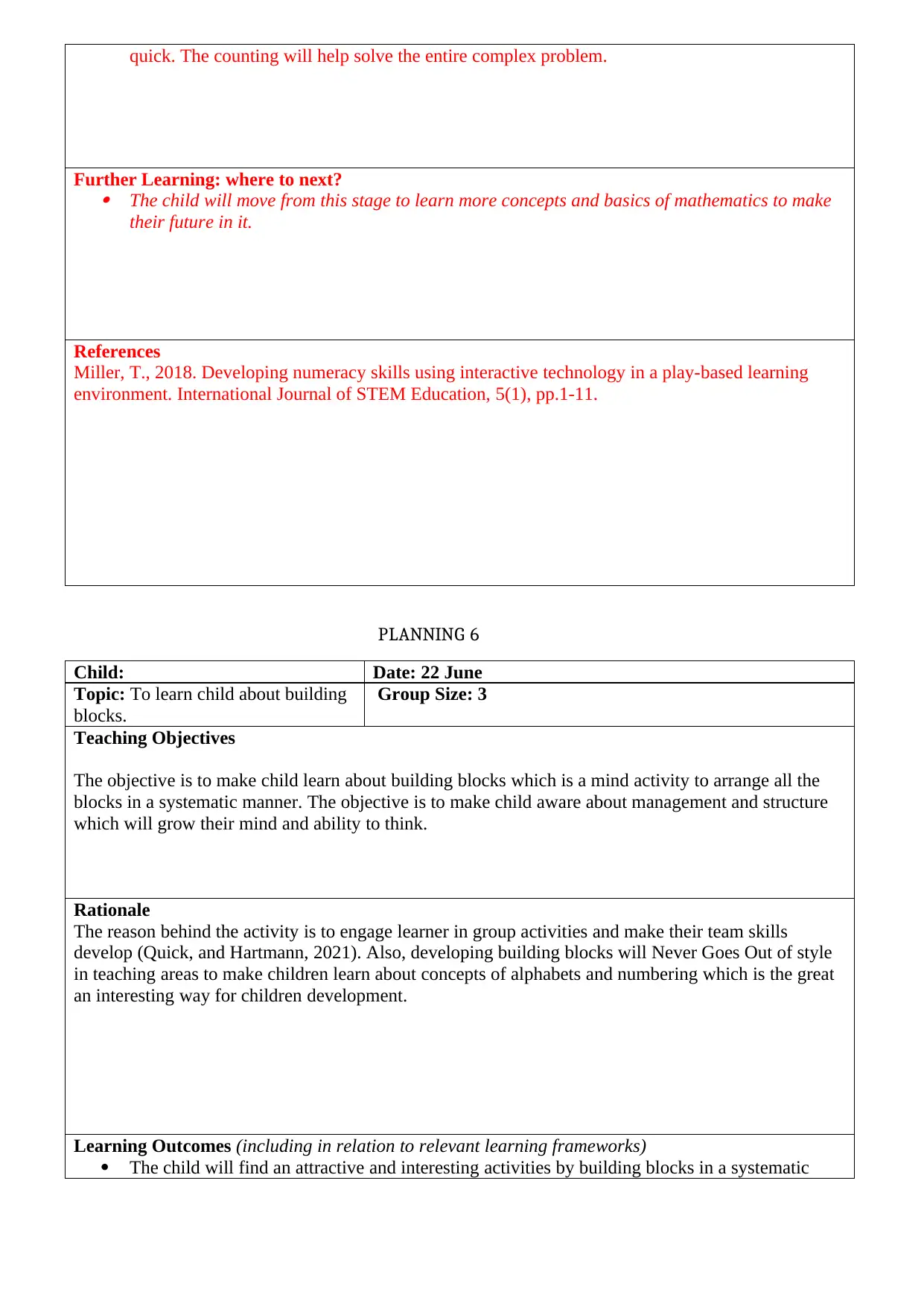
quick. The counting will help solve the entire complex problem.
Further Learning: where to next? The child will move from this stage to learn more concepts and basics of mathematics to make
their future in it.
References
Miller, T., 2018. Developing numeracy skills using interactive technology in a play-based learning
environment. International Journal of STEM Education, 5(1), pp.1-11.
PLANNING 6
Child: Date: 22 June
Topic: To learn child about building
blocks.
Group Size: 3
Teaching Objectives
The objective is to make child learn about building blocks which is a mind activity to arrange all the
blocks in a systematic manner. The objective is to make child aware about management and structure
which will grow their mind and ability to think.
Rationale
The reason behind the activity is to engage learner in group activities and make their team skills
develop (Quick, and Hartmann, 2021). Also, developing building blocks will Never Goes Out of style
in teaching areas to make children learn about concepts of alphabets and numbering which is the great
an interesting way for children development.
Learning Outcomes (including in relation to relevant learning frameworks)
The child will find an attractive and interesting activities by building blocks in a systematic
Further Learning: where to next? The child will move from this stage to learn more concepts and basics of mathematics to make
their future in it.
References
Miller, T., 2018. Developing numeracy skills using interactive technology in a play-based learning
environment. International Journal of STEM Education, 5(1), pp.1-11.
PLANNING 6
Child: Date: 22 June
Topic: To learn child about building
blocks.
Group Size: 3
Teaching Objectives
The objective is to make child learn about building blocks which is a mind activity to arrange all the
blocks in a systematic manner. The objective is to make child aware about management and structure
which will grow their mind and ability to think.
Rationale
The reason behind the activity is to engage learner in group activities and make their team skills
develop (Quick, and Hartmann, 2021). Also, developing building blocks will Never Goes Out of style
in teaching areas to make children learn about concepts of alphabets and numbering which is the great
an interesting way for children development.
Learning Outcomes (including in relation to relevant learning frameworks)
The child will find an attractive and interesting activities by building blocks in a systematic
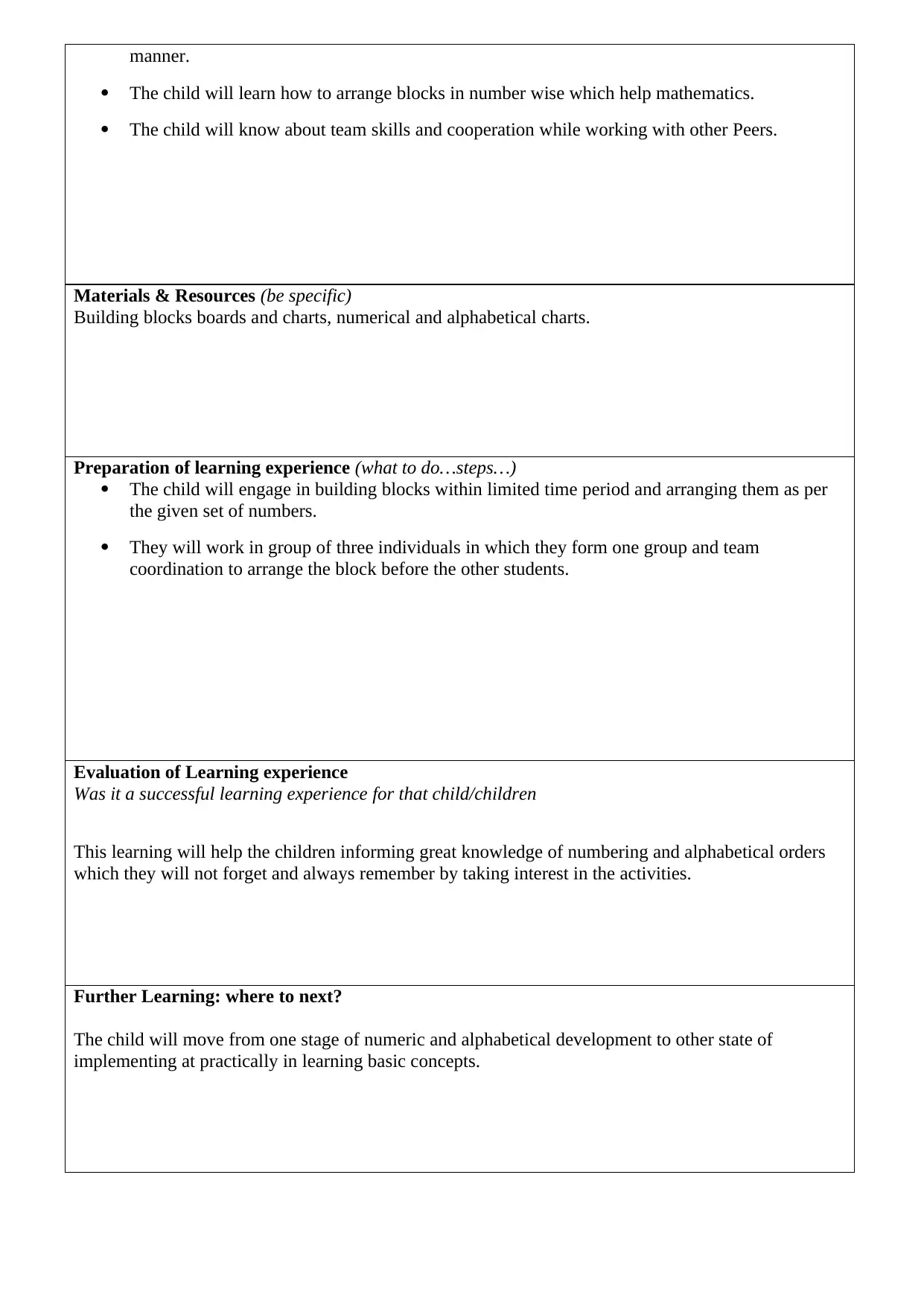
manner.
The child will learn how to arrange blocks in number wise which help mathematics.
The child will know about team skills and cooperation while working with other Peers.
Materials & Resources (be specific)
Building blocks boards and charts, numerical and alphabetical charts.
Preparation of learning experience (what to do…steps…)
The child will engage in building blocks within limited time period and arranging them as per
the given set of numbers.
They will work in group of three individuals in which they form one group and team
coordination to arrange the block before the other students.
Evaluation of Learning experience
Was it a successful learning experience for that child/children
This learning will help the children informing great knowledge of numbering and alphabetical orders
which they will not forget and always remember by taking interest in the activities.
Further Learning: where to next?
The child will move from one stage of numeric and alphabetical development to other state of
implementing at practically in learning basic concepts.
The child will learn how to arrange blocks in number wise which help mathematics.
The child will know about team skills and cooperation while working with other Peers.
Materials & Resources (be specific)
Building blocks boards and charts, numerical and alphabetical charts.
Preparation of learning experience (what to do…steps…)
The child will engage in building blocks within limited time period and arranging them as per
the given set of numbers.
They will work in group of three individuals in which they form one group and team
coordination to arrange the block before the other students.
Evaluation of Learning experience
Was it a successful learning experience for that child/children
This learning will help the children informing great knowledge of numbering and alphabetical orders
which they will not forget and always remember by taking interest in the activities.
Further Learning: where to next?
The child will move from one stage of numeric and alphabetical development to other state of
implementing at practically in learning basic concepts.
Secure Best Marks with AI Grader
Need help grading? Try our AI Grader for instant feedback on your assignments.
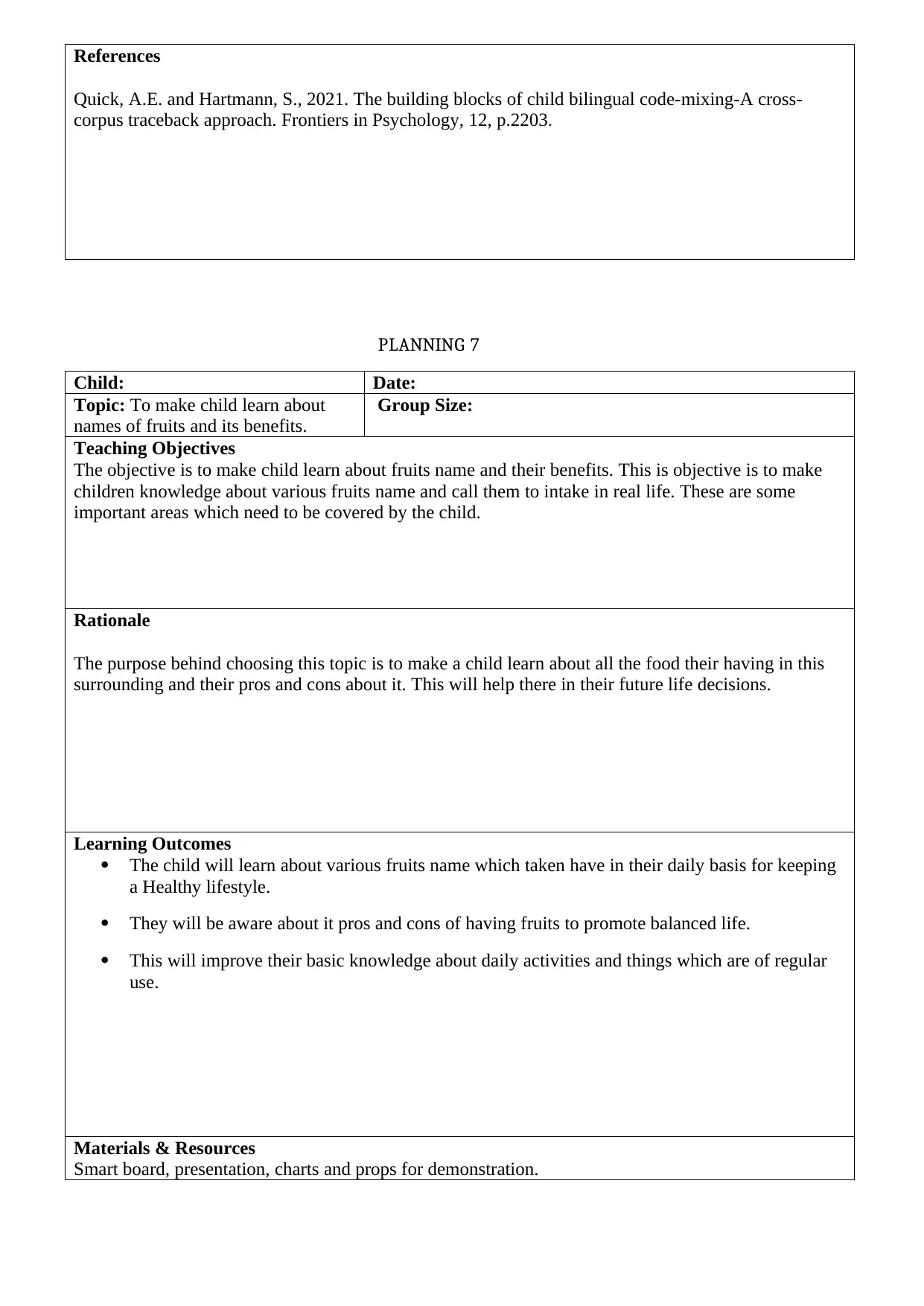
References
Quick, A.E. and Hartmann, S., 2021. The building blocks of child bilingual code-mixing-A cross-
corpus traceback approach. Frontiers in Psychology, 12, p.2203.
PLANNING 7
Child: Date:
Topic: To make child learn about
names of fruits and its benefits.
Group Size:
Teaching Objectives
The objective is to make child learn about fruits name and their benefits. This is objective is to make
children knowledge about various fruits name and call them to intake in real life. These are some
important areas which need to be covered by the child.
Rationale
The purpose behind choosing this topic is to make a child learn about all the food their having in this
surrounding and their pros and cons about it. This will help there in their future life decisions.
Learning Outcomes
The child will learn about various fruits name which taken have in their daily basis for keeping
a Healthy lifestyle.
They will be aware about it pros and cons of having fruits to promote balanced life.
This will improve their basic knowledge about daily activities and things which are of regular
use.
Materials & Resources
Smart board, presentation, charts and props for demonstration.
Quick, A.E. and Hartmann, S., 2021. The building blocks of child bilingual code-mixing-A cross-
corpus traceback approach. Frontiers in Psychology, 12, p.2203.
PLANNING 7
Child: Date:
Topic: To make child learn about
names of fruits and its benefits.
Group Size:
Teaching Objectives
The objective is to make child learn about fruits name and their benefits. This is objective is to make
children knowledge about various fruits name and call them to intake in real life. These are some
important areas which need to be covered by the child.
Rationale
The purpose behind choosing this topic is to make a child learn about all the food their having in this
surrounding and their pros and cons about it. This will help there in their future life decisions.
Learning Outcomes
The child will learn about various fruits name which taken have in their daily basis for keeping
a Healthy lifestyle.
They will be aware about it pros and cons of having fruits to promote balanced life.
This will improve their basic knowledge about daily activities and things which are of regular
use.
Materials & Resources
Smart board, presentation, charts and props for demonstration.
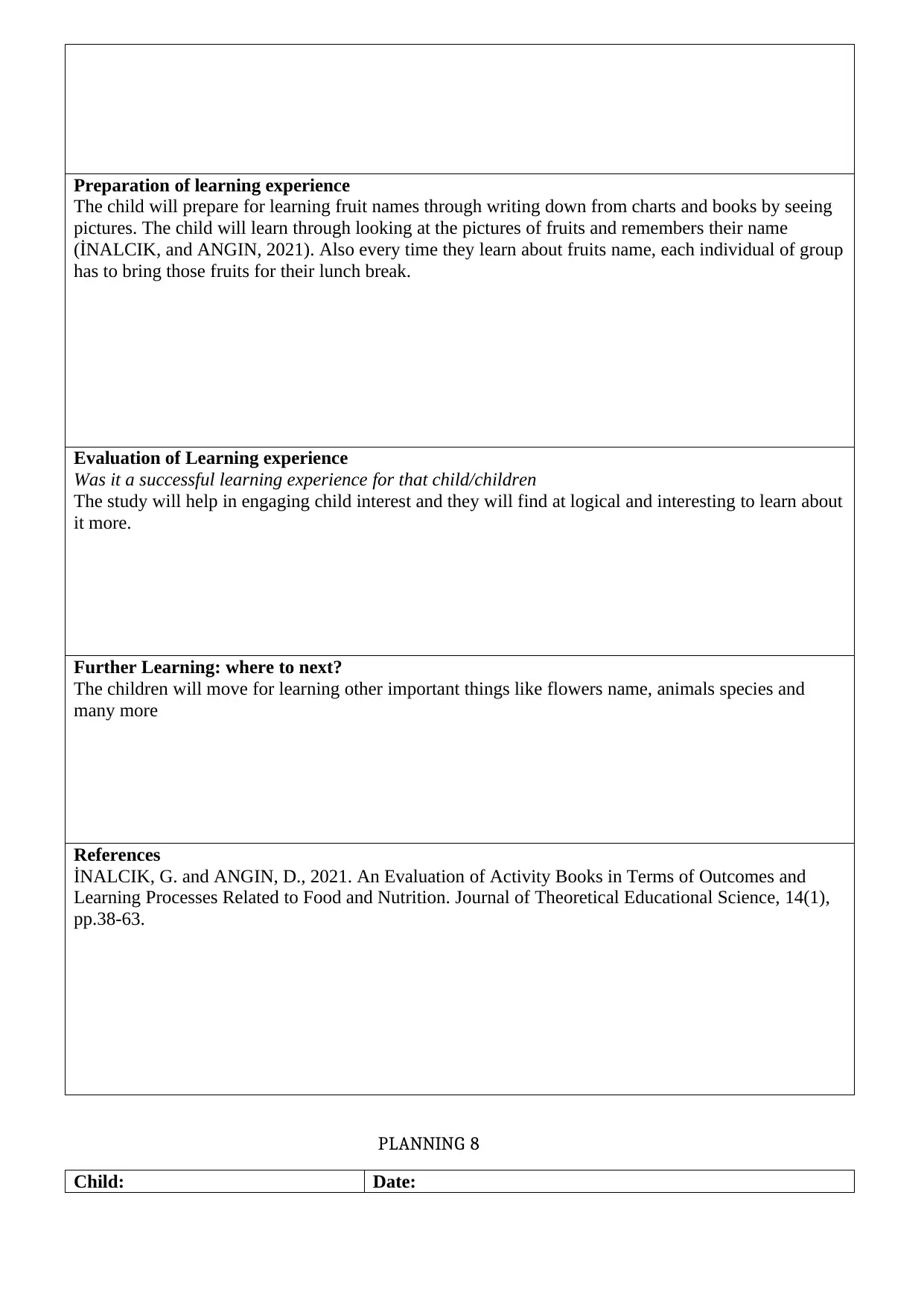
Preparation of learning experience
The child will prepare for learning fruit names through writing down from charts and books by seeing
pictures. The child will learn through looking at the pictures of fruits and remembers their name
(İNALCIK, and ANGIN, 2021). Also every time they learn about fruits name, each individual of group
has to bring those fruits for their lunch break.
Evaluation of Learning experience
Was it a successful learning experience for that child/children
The study will help in engaging child interest and they will find at logical and interesting to learn about
it more.
Further Learning: where to next?
The children will move for learning other important things like flowers name, animals species and
many more
References
İNALCIK, G. and ANGIN, D., 2021. An Evaluation of Activity Books in Terms of Outcomes and
Learning Processes Related to Food and Nutrition. Journal of Theoretical Educational Science, 14(1),
pp.38-63.
PLANNING 8
Child: Date:
The child will prepare for learning fruit names through writing down from charts and books by seeing
pictures. The child will learn through looking at the pictures of fruits and remembers their name
(İNALCIK, and ANGIN, 2021). Also every time they learn about fruits name, each individual of group
has to bring those fruits for their lunch break.
Evaluation of Learning experience
Was it a successful learning experience for that child/children
The study will help in engaging child interest and they will find at logical and interesting to learn about
it more.
Further Learning: where to next?
The children will move for learning other important things like flowers name, animals species and
many more
References
İNALCIK, G. and ANGIN, D., 2021. An Evaluation of Activity Books in Terms of Outcomes and
Learning Processes Related to Food and Nutrition. Journal of Theoretical Educational Science, 14(1),
pp.38-63.
PLANNING 8
Child: Date:
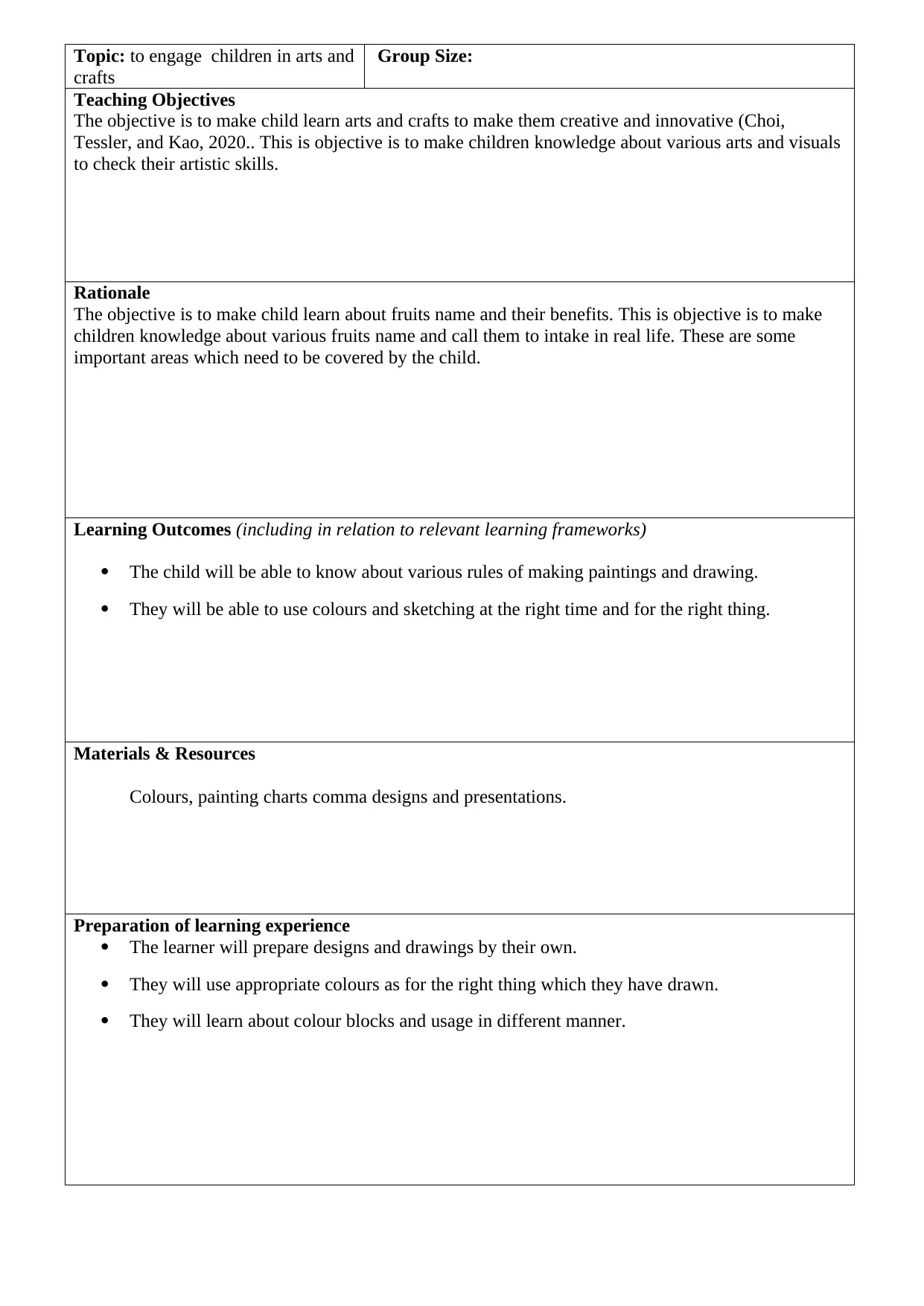
Topic: to engage children in arts and
crafts
Group Size:
Teaching Objectives
The objective is to make child learn arts and crafts to make them creative and innovative (Choi,
Tessler, and Kao, 2020.. This is objective is to make children knowledge about various arts and visuals
to check their artistic skills.
Rationale
The objective is to make child learn about fruits name and their benefits. This is objective is to make
children knowledge about various fruits name and call them to intake in real life. These are some
important areas which need to be covered by the child.
Learning Outcomes (including in relation to relevant learning frameworks)
The child will be able to know about various rules of making paintings and drawing.
They will be able to use colours and sketching at the right time and for the right thing.
Materials & Resources
Colours, painting charts comma designs and presentations.
Preparation of learning experience
The learner will prepare designs and drawings by their own.
They will use appropriate colours as for the right thing which they have drawn.
They will learn about colour blocks and usage in different manner.
crafts
Group Size:
Teaching Objectives
The objective is to make child learn arts and crafts to make them creative and innovative (Choi,
Tessler, and Kao, 2020.. This is objective is to make children knowledge about various arts and visuals
to check their artistic skills.
Rationale
The objective is to make child learn about fruits name and their benefits. This is objective is to make
children knowledge about various fruits name and call them to intake in real life. These are some
important areas which need to be covered by the child.
Learning Outcomes (including in relation to relevant learning frameworks)
The child will be able to know about various rules of making paintings and drawing.
They will be able to use colours and sketching at the right time and for the right thing.
Materials & Resources
Colours, painting charts comma designs and presentations.
Preparation of learning experience
The learner will prepare designs and drawings by their own.
They will use appropriate colours as for the right thing which they have drawn.
They will learn about colour blocks and usage in different manner.
Paraphrase This Document
Need a fresh take? Get an instant paraphrase of this document with our AI Paraphraser
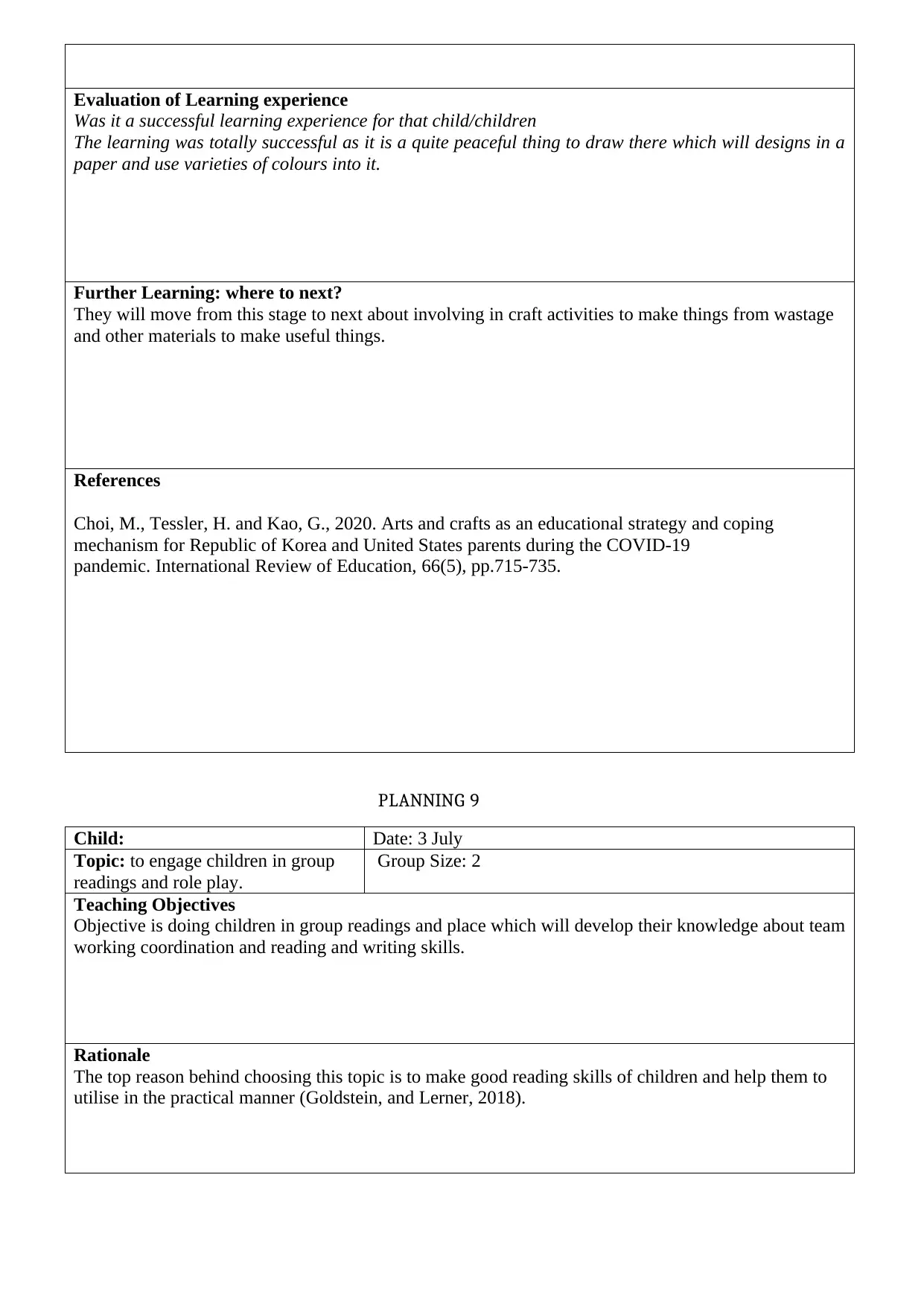
Evaluation of Learning experience
Was it a successful learning experience for that child/children
The learning was totally successful as it is a quite peaceful thing to draw there which will designs in a
paper and use varieties of colours into it.
Further Learning: where to next?
They will move from this stage to next about involving in craft activities to make things from wastage
and other materials to make useful things.
References
Choi, M., Tessler, H. and Kao, G., 2020. Arts and crafts as an educational strategy and coping
mechanism for Republic of Korea and United States parents during the COVID-19
pandemic. International Review of Education, 66(5), pp.715-735.
PLANNING 9
Child: Date: 3 July
Topic: to engage children in group
readings and role play.
Group Size: 2
Teaching Objectives
Objective is doing children in group readings and place which will develop their knowledge about team
working coordination and reading and writing skills.
Rationale
The top reason behind choosing this topic is to make good reading skills of children and help them to
utilise in the practical manner (Goldstein, and Lerner, 2018).
Was it a successful learning experience for that child/children
The learning was totally successful as it is a quite peaceful thing to draw there which will designs in a
paper and use varieties of colours into it.
Further Learning: where to next?
They will move from this stage to next about involving in craft activities to make things from wastage
and other materials to make useful things.
References
Choi, M., Tessler, H. and Kao, G., 2020. Arts and crafts as an educational strategy and coping
mechanism for Republic of Korea and United States parents during the COVID-19
pandemic. International Review of Education, 66(5), pp.715-735.
PLANNING 9
Child: Date: 3 July
Topic: to engage children in group
readings and role play.
Group Size: 2
Teaching Objectives
Objective is doing children in group readings and place which will develop their knowledge about team
working coordination and reading and writing skills.
Rationale
The top reason behind choosing this topic is to make good reading skills of children and help them to
utilise in the practical manner (Goldstein, and Lerner, 2018).
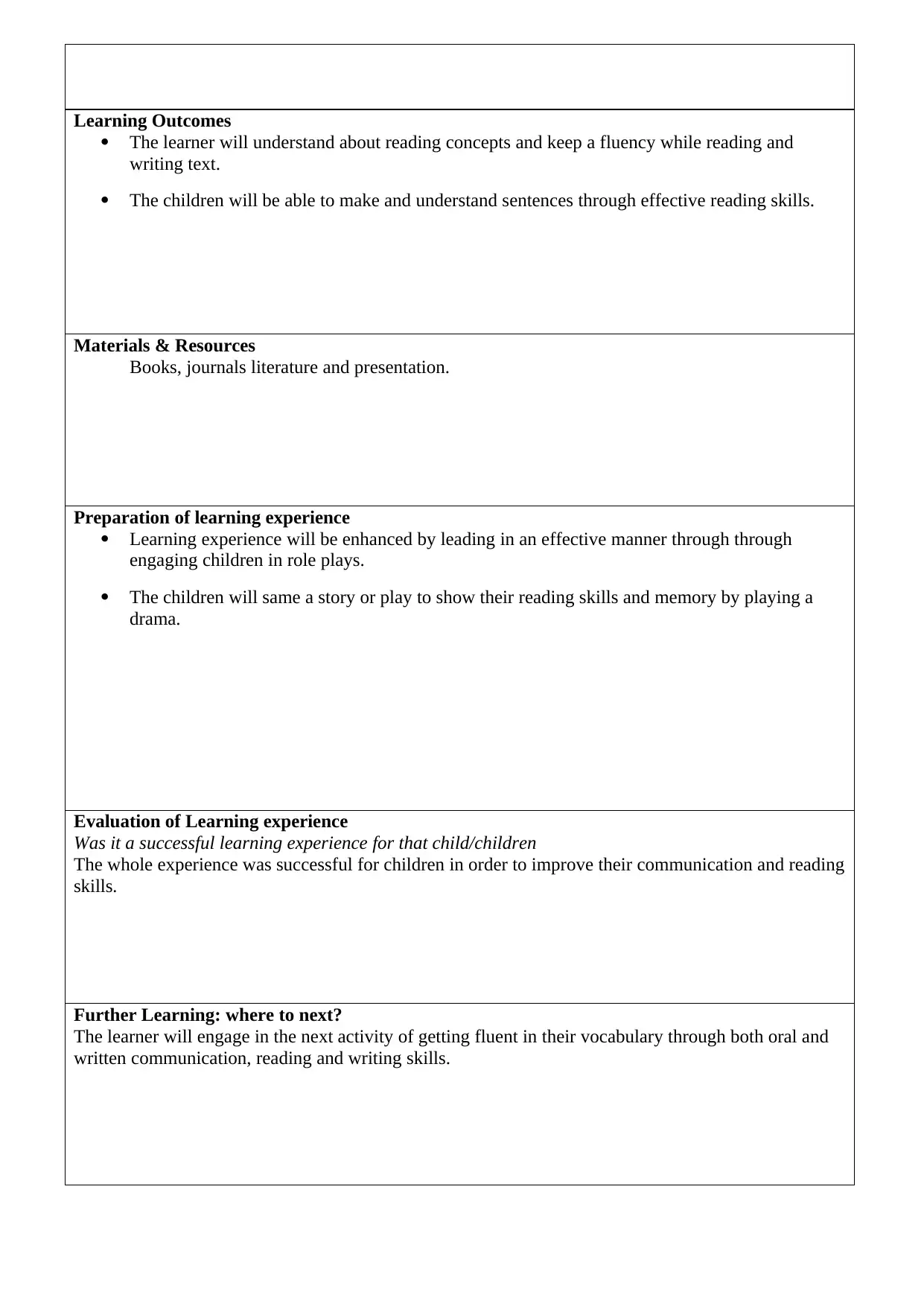
Learning Outcomes
The learner will understand about reading concepts and keep a fluency while reading and
writing text.
The children will be able to make and understand sentences through effective reading skills.
Materials & Resources
Books, journals literature and presentation.
Preparation of learning experience
Learning experience will be enhanced by leading in an effective manner through through
engaging children in role plays.
The children will same a story or play to show their reading skills and memory by playing a
drama.
Evaluation of Learning experience
Was it a successful learning experience for that child/children
The whole experience was successful for children in order to improve their communication and reading
skills.
Further Learning: where to next?
The learner will engage in the next activity of getting fluent in their vocabulary through both oral and
written communication, reading and writing skills.
The learner will understand about reading concepts and keep a fluency while reading and
writing text.
The children will be able to make and understand sentences through effective reading skills.
Materials & Resources
Books, journals literature and presentation.
Preparation of learning experience
Learning experience will be enhanced by leading in an effective manner through through
engaging children in role plays.
The children will same a story or play to show their reading skills and memory by playing a
drama.
Evaluation of Learning experience
Was it a successful learning experience for that child/children
The whole experience was successful for children in order to improve their communication and reading
skills.
Further Learning: where to next?
The learner will engage in the next activity of getting fluent in their vocabulary through both oral and
written communication, reading and writing skills.
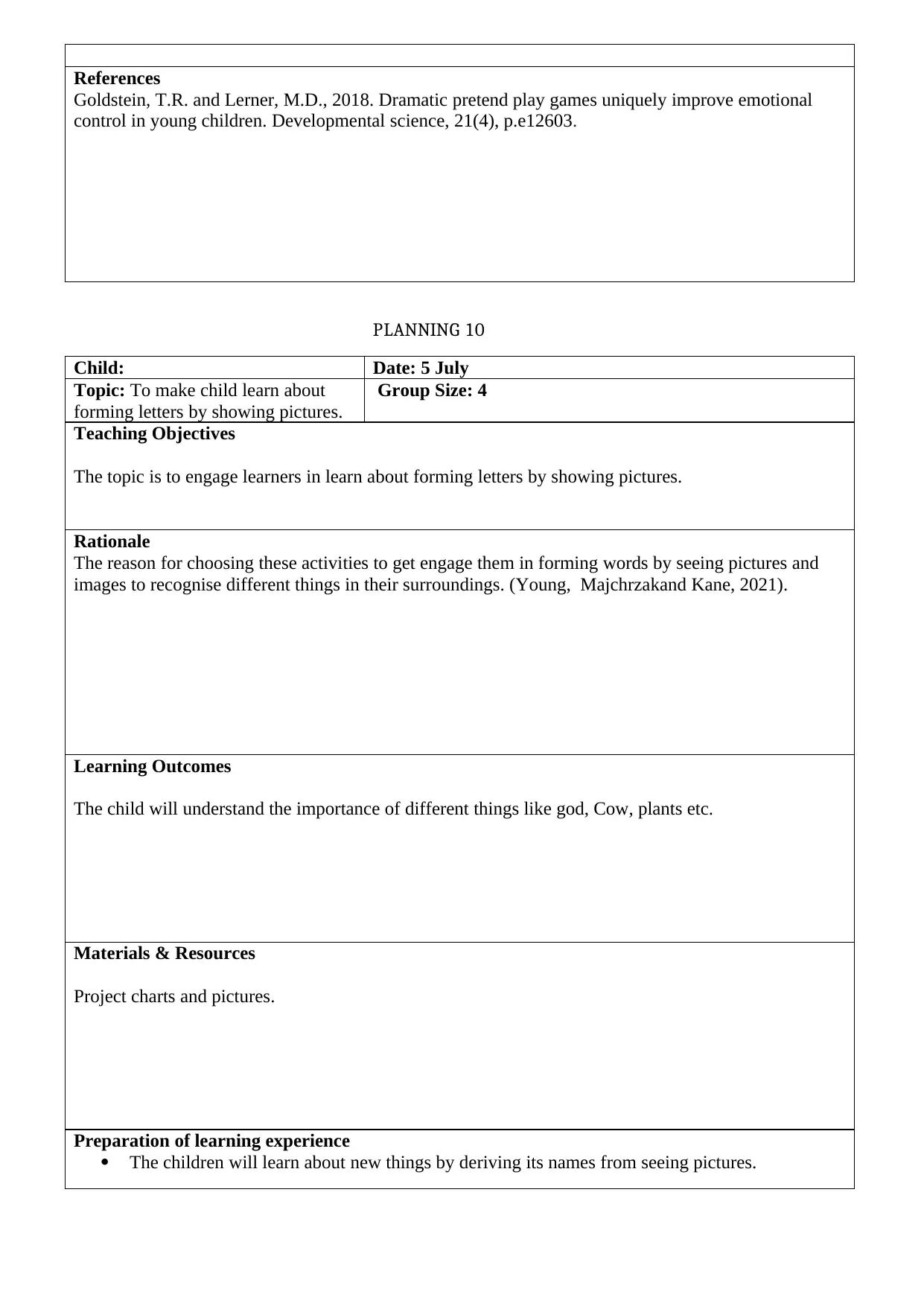
References
Goldstein, T.R. and Lerner, M.D., 2018. Dramatic pretend play games uniquely improve emotional
control in young children. Developmental science, 21(4), p.e12603.
PLANNING 10
Child: Date: 5 July
Topic: To make child learn about
forming letters by showing pictures.
Group Size: 4
Teaching Objectives
The topic is to engage learners in learn about forming letters by showing pictures.
Rationale
The reason for choosing these activities to get engage them in forming words by seeing pictures and
images to recognise different things in their surroundings. (Young, Majchrzakand Kane, 2021).
Learning Outcomes
The child will understand the importance of different things like god, Cow, plants etc.
Materials & Resources
Project charts and pictures.
Preparation of learning experience
The children will learn about new things by deriving its names from seeing pictures.
Goldstein, T.R. and Lerner, M.D., 2018. Dramatic pretend play games uniquely improve emotional
control in young children. Developmental science, 21(4), p.e12603.
PLANNING 10
Child: Date: 5 July
Topic: To make child learn about
forming letters by showing pictures.
Group Size: 4
Teaching Objectives
The topic is to engage learners in learn about forming letters by showing pictures.
Rationale
The reason for choosing these activities to get engage them in forming words by seeing pictures and
images to recognise different things in their surroundings. (Young, Majchrzakand Kane, 2021).
Learning Outcomes
The child will understand the importance of different things like god, Cow, plants etc.
Materials & Resources
Project charts and pictures.
Preparation of learning experience
The children will learn about new things by deriving its names from seeing pictures.
Secure Best Marks with AI Grader
Need help grading? Try our AI Grader for instant feedback on your assignments.
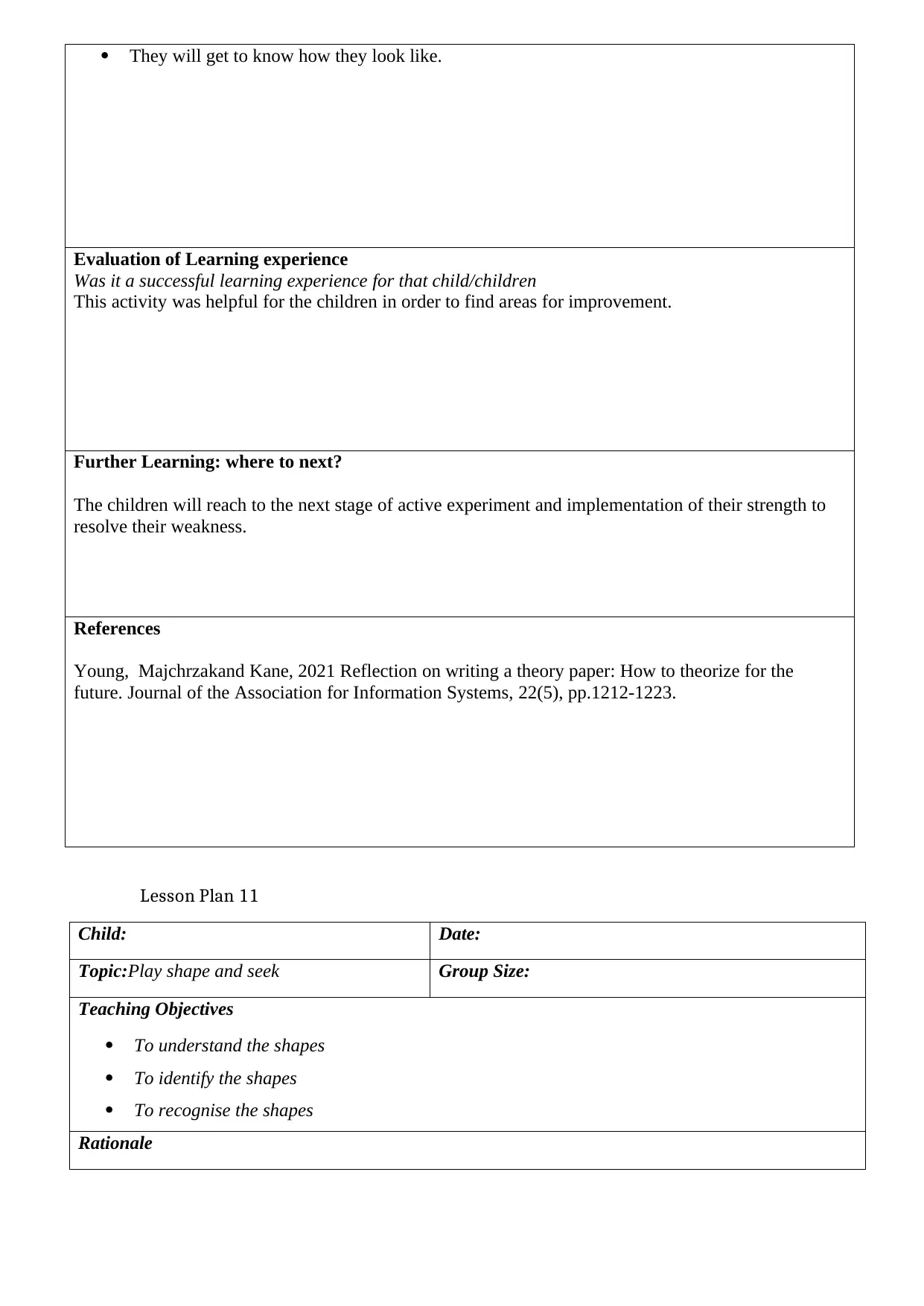
They will get to know how they look like.
Evaluation of Learning experience
Was it a successful learning experience for that child/children
This activity was helpful for the children in order to find areas for improvement.
Further Learning: where to next?
The children will reach to the next stage of active experiment and implementation of their strength to
resolve their weakness.
References
Young, Majchrzakand Kane, 2021 Reflection on writing a theory paper: How to theorize for the
future. Journal of the Association for Information Systems, 22(5), pp.1212-1223.
Lesson Plan 11
Child: Date:
Topic:Play shape and seek Group Size:
Teaching Objectives
To understand the shapes
To identify the shapes
To recognise the shapes
Rationale
Evaluation of Learning experience
Was it a successful learning experience for that child/children
This activity was helpful for the children in order to find areas for improvement.
Further Learning: where to next?
The children will reach to the next stage of active experiment and implementation of their strength to
resolve their weakness.
References
Young, Majchrzakand Kane, 2021 Reflection on writing a theory paper: How to theorize for the
future. Journal of the Association for Information Systems, 22(5), pp.1212-1223.
Lesson Plan 11
Child: Date:
Topic:Play shape and seek Group Size:
Teaching Objectives
To understand the shapes
To identify the shapes
To recognise the shapes
Rationale
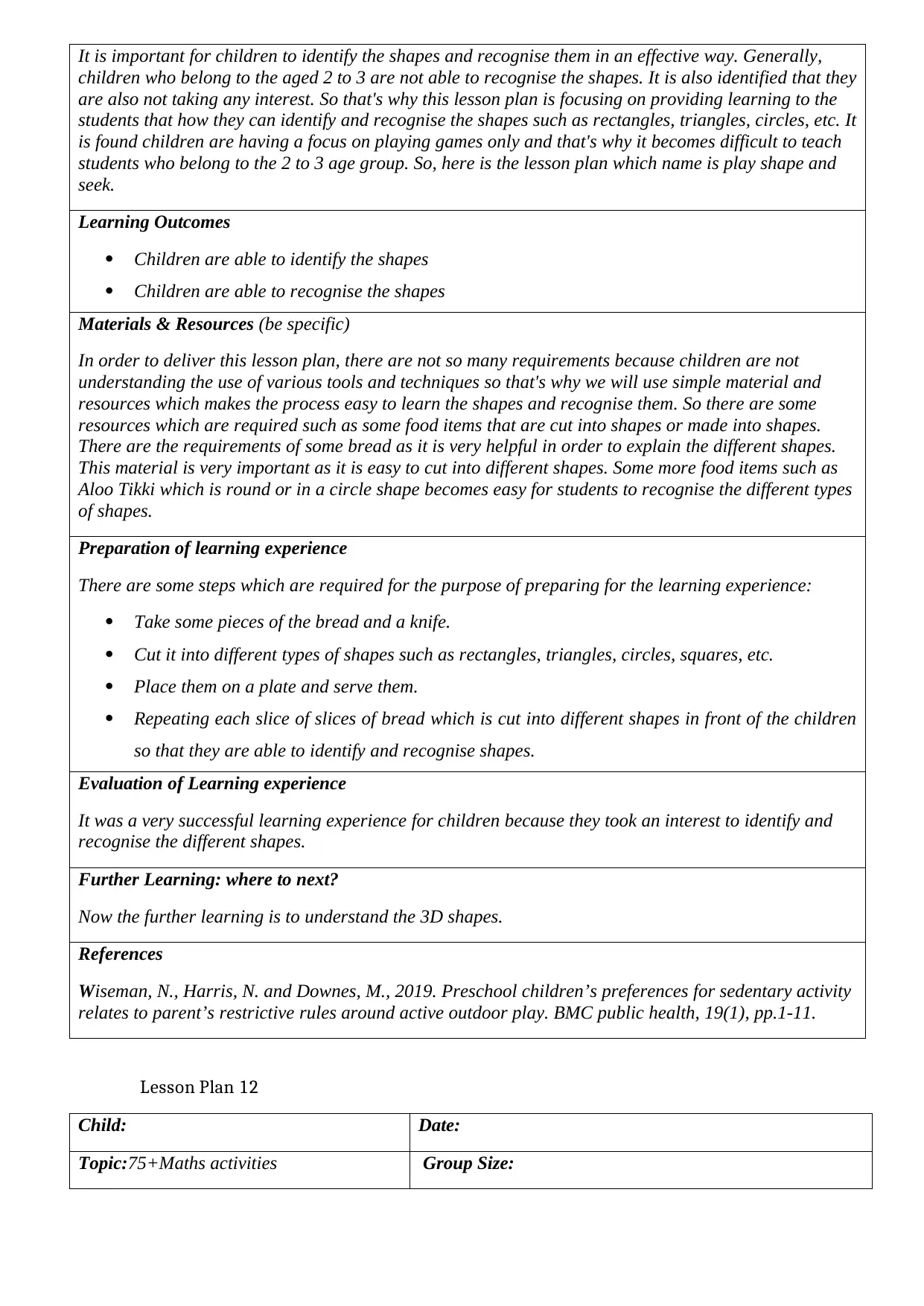
It is important for children to identify the shapes and recognise them in an effective way. Generally,
children who belong to the aged 2 to 3 are not able to recognise the shapes. It is also identified that they
are also not taking any interest. So that's why this lesson plan is focusing on providing learning to the
students that how they can identify and recognise the shapes such as rectangles, triangles, circles, etc. It
is found children are having a focus on playing games only and that's why it becomes difficult to teach
students who belong to the 2 to 3 age group. So, here is the lesson plan which name is play shape and
seek.
Learning Outcomes
Children are able to identify the shapes
Children are able to recognise the shapes
Materials & Resources (be specific)
In order to deliver this lesson plan, there are not so many requirements because children are not
understanding the use of various tools and techniques so that's why we will use simple material and
resources which makes the process easy to learn the shapes and recognise them. So there are some
resources which are required such as some food items that are cut into shapes or made into shapes.
There are the requirements of some bread as it is very helpful in order to explain the different shapes.
This material is very important as it is easy to cut into different shapes. Some more food items such as
Aloo Tikki which is round or in a circle shape becomes easy for students to recognise the different types
of shapes.
Preparation of learning experience
There are some steps which are required for the purpose of preparing for the learning experience:
Take some pieces of the bread and a knife.
Cut it into different types of shapes such as rectangles, triangles, circles, squares, etc.
Place them on a plate and serve them.
Repeating each slice of slices of bread which is cut into different shapes in front of the children
so that they are able to identify and recognise shapes.
Evaluation of Learning experience
It was a very successful learning experience for children because they took an interest to identify and
recognise the different shapes.
Further Learning: where to next?
Now the further learning is to understand the 3D shapes.
References
Wiseman, N., Harris, N. and Downes, M., 2019. Preschool children’s preferences for sedentary activity
relates to parent’s restrictive rules around active outdoor play. BMC public health, 19(1), pp.1-11.
Lesson Plan 12
Child: Date:
Topic:75+Maths activities Group Size:
children who belong to the aged 2 to 3 are not able to recognise the shapes. It is also identified that they
are also not taking any interest. So that's why this lesson plan is focusing on providing learning to the
students that how they can identify and recognise the shapes such as rectangles, triangles, circles, etc. It
is found children are having a focus on playing games only and that's why it becomes difficult to teach
students who belong to the 2 to 3 age group. So, here is the lesson plan which name is play shape and
seek.
Learning Outcomes
Children are able to identify the shapes
Children are able to recognise the shapes
Materials & Resources (be specific)
In order to deliver this lesson plan, there are not so many requirements because children are not
understanding the use of various tools and techniques so that's why we will use simple material and
resources which makes the process easy to learn the shapes and recognise them. So there are some
resources which are required such as some food items that are cut into shapes or made into shapes.
There are the requirements of some bread as it is very helpful in order to explain the different shapes.
This material is very important as it is easy to cut into different shapes. Some more food items such as
Aloo Tikki which is round or in a circle shape becomes easy for students to recognise the different types
of shapes.
Preparation of learning experience
There are some steps which are required for the purpose of preparing for the learning experience:
Take some pieces of the bread and a knife.
Cut it into different types of shapes such as rectangles, triangles, circles, squares, etc.
Place them on a plate and serve them.
Repeating each slice of slices of bread which is cut into different shapes in front of the children
so that they are able to identify and recognise shapes.
Evaluation of Learning experience
It was a very successful learning experience for children because they took an interest to identify and
recognise the different shapes.
Further Learning: where to next?
Now the further learning is to understand the 3D shapes.
References
Wiseman, N., Harris, N. and Downes, M., 2019. Preschool children’s preferences for sedentary activity
relates to parent’s restrictive rules around active outdoor play. BMC public health, 19(1), pp.1-11.
Lesson Plan 12
Child: Date:
Topic:75+Maths activities Group Size:
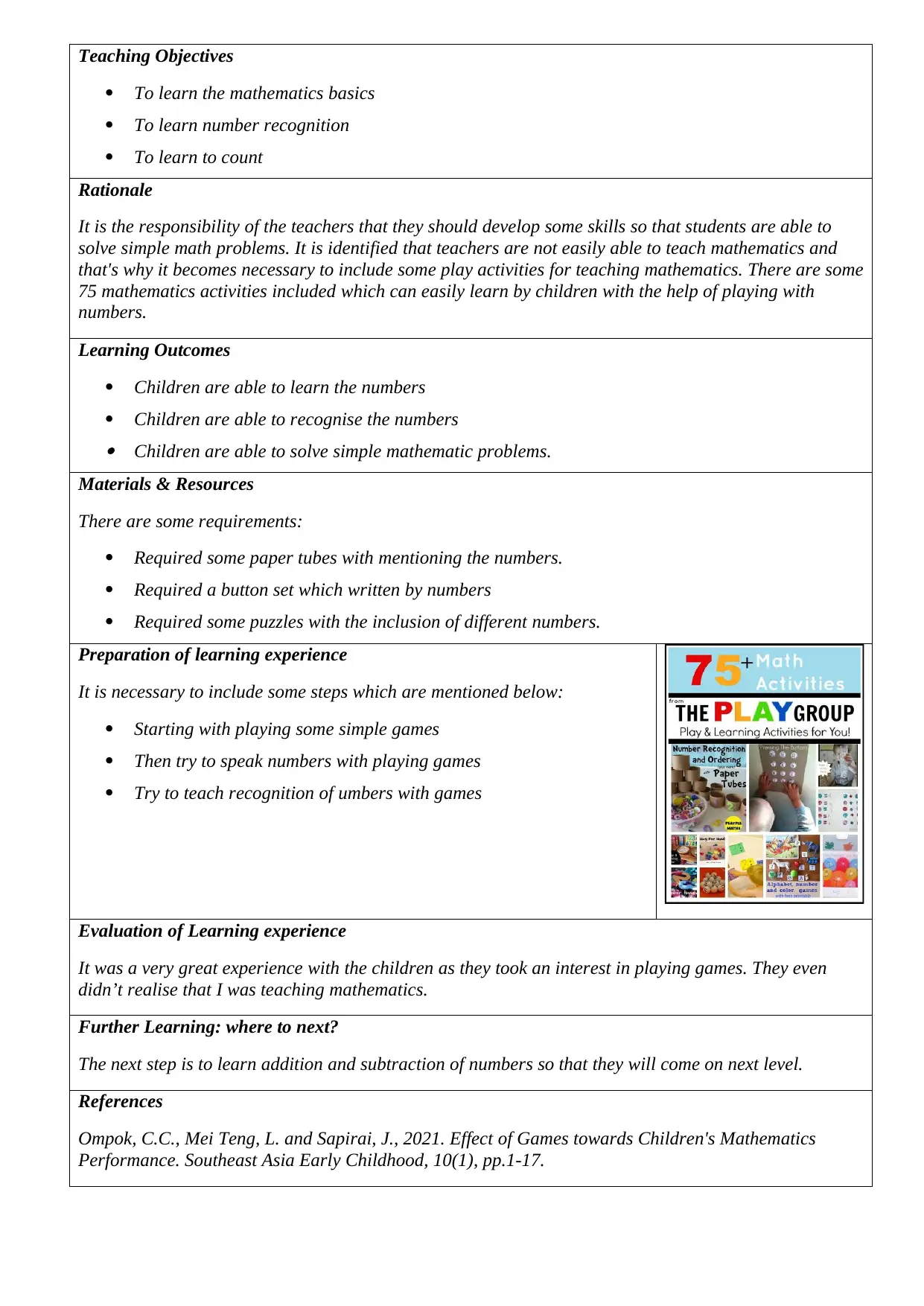
Teaching Objectives
To learn the mathematics basics
To learn number recognition
To learn to count
Rationale
It is the responsibility of the teachers that they should develop some skills so that students are able to
solve simple math problems. It is identified that teachers are not easily able to teach mathematics and
that's why it becomes necessary to include some play activities for teaching mathematics. There are some
75 mathematics activities included which can easily learn by children with the help of playing with
numbers.
Learning Outcomes
Children are able to learn the numbers
Children are able to recognise the numbers Children are able to solve simple mathematic problems.
Materials & Resources
There are some requirements:
Required some paper tubes with mentioning the numbers.
Required a button set which written by numbers
Required some puzzles with the inclusion of different numbers.
Preparation of learning experience
It is necessary to include some steps which are mentioned below:
Starting with playing some simple games
Then try to speak numbers with playing games
Try to teach recognition of umbers with games
Evaluation of Learning experience
It was a very great experience with the children as they took an interest in playing games. They even
didn’t realise that I was teaching mathematics.
Further Learning: where to next?
The next step is to learn addition and subtraction of numbers so that they will come on next level.
References
Ompok, C.C., Mei Teng, L. and Sapirai, J., 2021. Effect of Games towards Children's Mathematics
Performance. Southeast Asia Early Childhood, 10(1), pp.1-17.
To learn the mathematics basics
To learn number recognition
To learn to count
Rationale
It is the responsibility of the teachers that they should develop some skills so that students are able to
solve simple math problems. It is identified that teachers are not easily able to teach mathematics and
that's why it becomes necessary to include some play activities for teaching mathematics. There are some
75 mathematics activities included which can easily learn by children with the help of playing with
numbers.
Learning Outcomes
Children are able to learn the numbers
Children are able to recognise the numbers Children are able to solve simple mathematic problems.
Materials & Resources
There are some requirements:
Required some paper tubes with mentioning the numbers.
Required a button set which written by numbers
Required some puzzles with the inclusion of different numbers.
Preparation of learning experience
It is necessary to include some steps which are mentioned below:
Starting with playing some simple games
Then try to speak numbers with playing games
Try to teach recognition of umbers with games
Evaluation of Learning experience
It was a very great experience with the children as they took an interest in playing games. They even
didn’t realise that I was teaching mathematics.
Further Learning: where to next?
The next step is to learn addition and subtraction of numbers so that they will come on next level.
References
Ompok, C.C., Mei Teng, L. and Sapirai, J., 2021. Effect of Games towards Children's Mathematics
Performance. Southeast Asia Early Childhood, 10(1), pp.1-17.
Paraphrase This Document
Need a fresh take? Get an instant paraphrase of this document with our AI Paraphraser


Lesson Plan 13
Child: Date:
Topic:Colour sorting game Group Size:
Teaching Objectives
To learn the name of colours
Identify and recognise different colours
Rationale
Learning the colours' names and recognising them is very important for the children and that's why
every teacher and parent is trying to teach their toddlers for teaching colours but it is not an easy
process because they are only focusing on playing games. This is the reason that this idea is
choosing and making a lesson plan for toddlers so that they are able to learn the names of colours.
The idea is very effective as children are able to take interest in these types of games.
Learning Outcomes Able to learn the colours names Able to identify and recognise the colours names
Materials & Resources
Some important materials which are required for playing with ball pit balls:
A tent
A cardboard box
A Flexi tube
A paddling pool
A plastic shell
A laundry basket
A port a cot
Under-bed storage bin
Preparation of learning experience
Prepare to make a game and start ready for playing with children:
The first step is to make a game properly
Start to play with children
Stand up in front of the cardboard in which different colours of
balls in the shape of the circle are cut into the cardboard
Give one colour ball to the children and told that they should
throw in the same colour of the ball in the same colour
cardboard circle.
It is the game of ball pit ball which is also known as throw and
Child: Date:
Topic:Colour sorting game Group Size:
Teaching Objectives
To learn the name of colours
Identify and recognise different colours
Rationale
Learning the colours' names and recognising them is very important for the children and that's why
every teacher and parent is trying to teach their toddlers for teaching colours but it is not an easy
process because they are only focusing on playing games. This is the reason that this idea is
choosing and making a lesson plan for toddlers so that they are able to learn the names of colours.
The idea is very effective as children are able to take interest in these types of games.
Learning Outcomes Able to learn the colours names Able to identify and recognise the colours names
Materials & Resources
Some important materials which are required for playing with ball pit balls:
A tent
A cardboard box
A Flexi tube
A paddling pool
A plastic shell
A laundry basket
A port a cot
Under-bed storage bin
Preparation of learning experience
Prepare to make a game and start ready for playing with children:
The first step is to make a game properly
Start to play with children
Stand up in front of the cardboard in which different colours of
balls in the shape of the circle are cut into the cardboard
Give one colour ball to the children and told that they should
throw in the same colour of the ball in the same colour
cardboard circle.
It is the game of ball pit ball which is also known as throw and
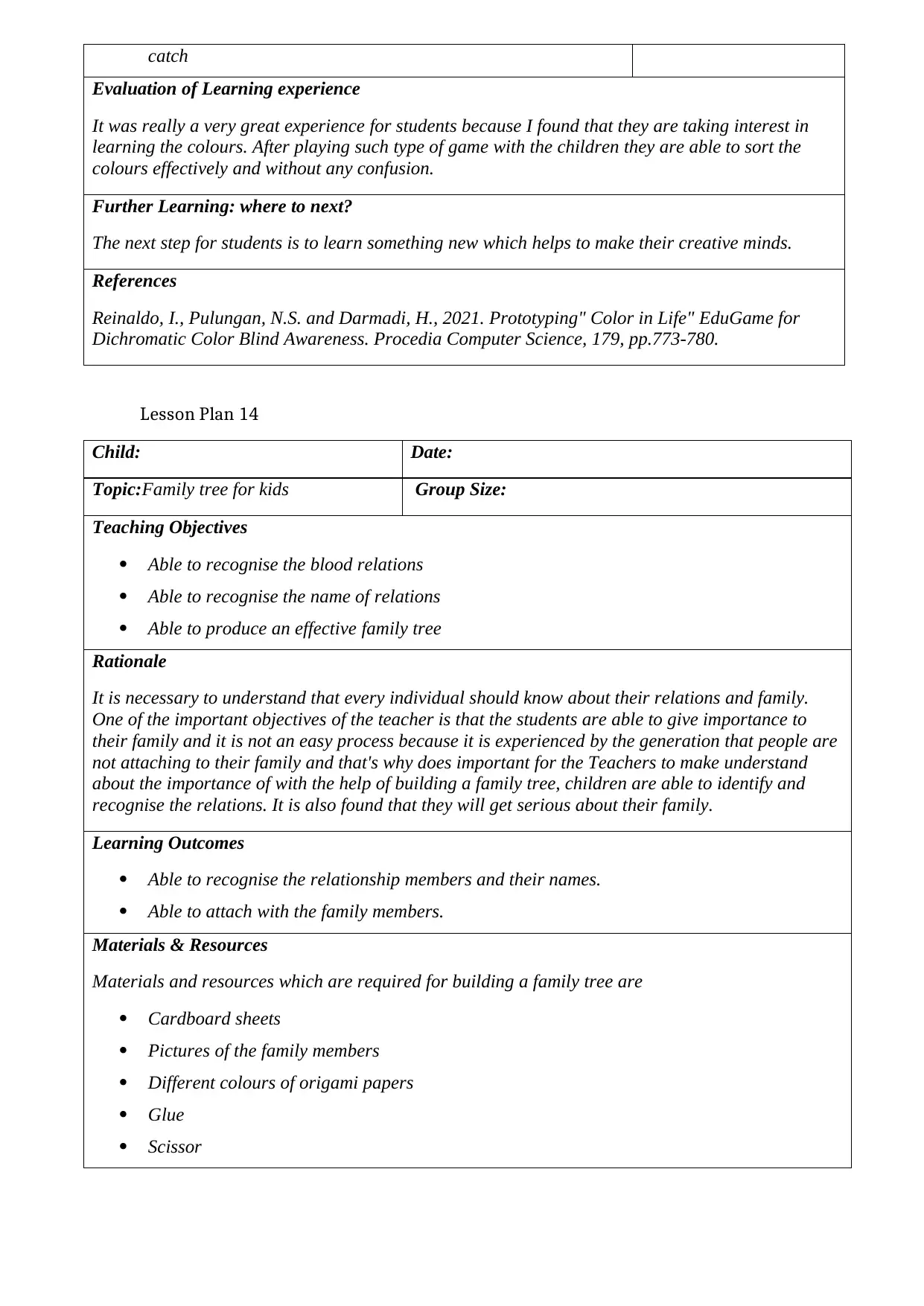
catch
Evaluation of Learning experience
It was really a very great experience for students because I found that they are taking interest in
learning the colours. After playing such type of game with the children they are able to sort the
colours effectively and without any confusion.
Further Learning: where to next?
The next step for students is to learn something new which helps to make their creative minds.
References
Reinaldo, I., Pulungan, N.S. and Darmadi, H., 2021. Prototyping" Color in Life" EduGame for
Dichromatic Color Blind Awareness. Procedia Computer Science, 179, pp.773-780.
Lesson Plan 14
Child: Date:
Topic:Family tree for kids Group Size:
Teaching Objectives
Able to recognise the blood relations
Able to recognise the name of relations
Able to produce an effective family tree
Rationale
It is necessary to understand that every individual should know about their relations and family.
One of the important objectives of the teacher is that the students are able to give importance to
their family and it is not an easy process because it is experienced by the generation that people are
not attaching to their family and that's why does important for the Teachers to make understand
about the importance of with the help of building a family tree, children are able to identify and
recognise the relations. It is also found that they will get serious about their family.
Learning Outcomes
Able to recognise the relationship members and their names.
Able to attach with the family members.
Materials & Resources
Materials and resources which are required for building a family tree are
Cardboard sheets
Pictures of the family members
Different colours of origami papers
Glue
Scissor
Evaluation of Learning experience
It was really a very great experience for students because I found that they are taking interest in
learning the colours. After playing such type of game with the children they are able to sort the
colours effectively and without any confusion.
Further Learning: where to next?
The next step for students is to learn something new which helps to make their creative minds.
References
Reinaldo, I., Pulungan, N.S. and Darmadi, H., 2021. Prototyping" Color in Life" EduGame for
Dichromatic Color Blind Awareness. Procedia Computer Science, 179, pp.773-780.
Lesson Plan 14
Child: Date:
Topic:Family tree for kids Group Size:
Teaching Objectives
Able to recognise the blood relations
Able to recognise the name of relations
Able to produce an effective family tree
Rationale
It is necessary to understand that every individual should know about their relations and family.
One of the important objectives of the teacher is that the students are able to give importance to
their family and it is not an easy process because it is experienced by the generation that people are
not attaching to their family and that's why does important for the Teachers to make understand
about the importance of with the help of building a family tree, children are able to identify and
recognise the relations. It is also found that they will get serious about their family.
Learning Outcomes
Able to recognise the relationship members and their names.
Able to attach with the family members.
Materials & Resources
Materials and resources which are required for building a family tree are
Cardboard sheets
Pictures of the family members
Different colours of origami papers
Glue
Scissor
Secure Best Marks with AI Grader
Need help grading? Try our AI Grader for instant feedback on your assignments.
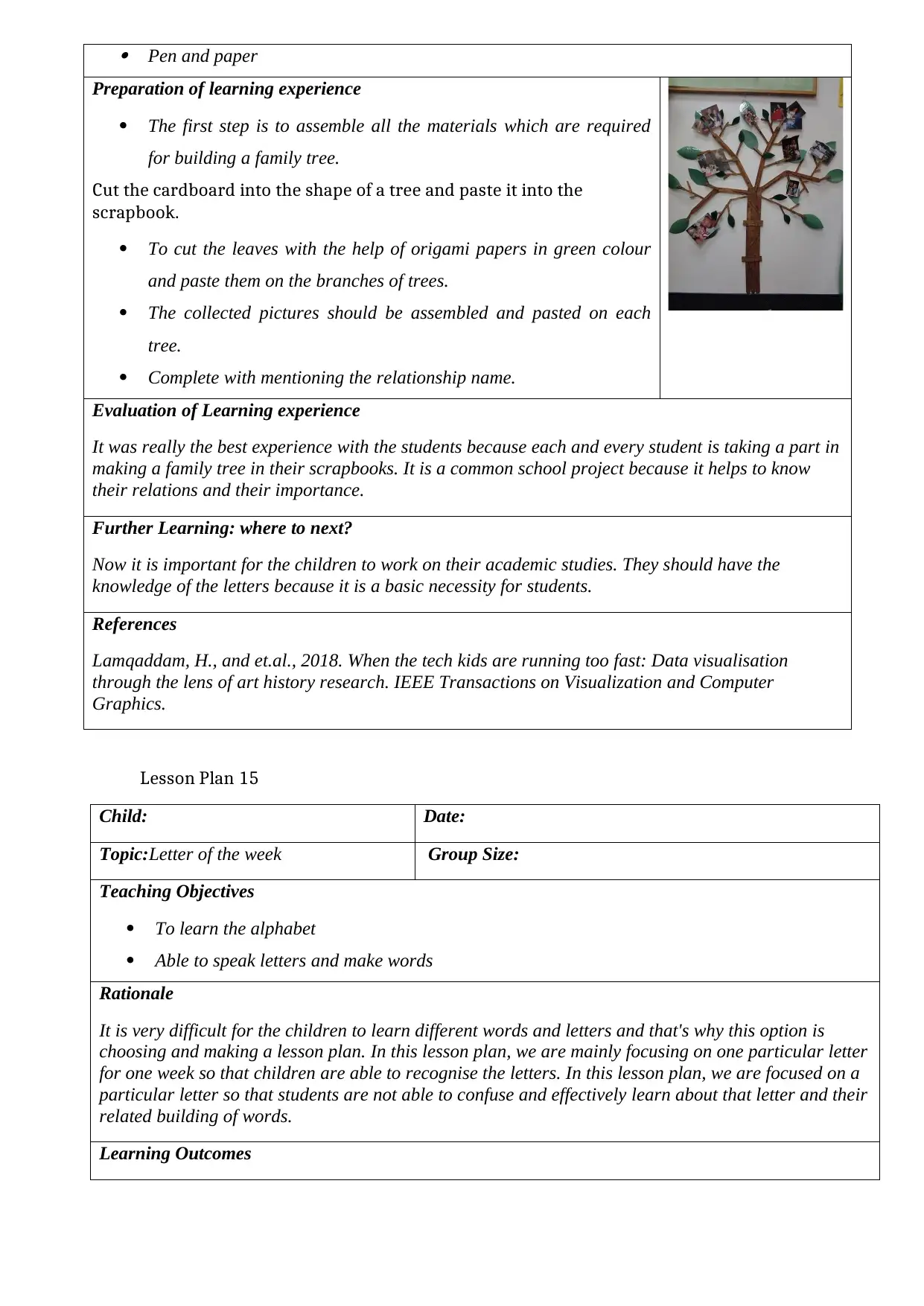
Pen and paper
Preparation of learning experience
The first step is to assemble all the materials which are required
for building a family tree.
Cut the cardboard into the shape of a tree and paste it into the
scrapbook.
To cut the leaves with the help of origami papers in green colour
and paste them on the branches of trees.
The collected pictures should be assembled and pasted on each
tree.
Complete with mentioning the relationship name.
Evaluation of Learning experience
It was really the best experience with the students because each and every student is taking a part in
making a family tree in their scrapbooks. It is a common school project because it helps to know
their relations and their importance.
Further Learning: where to next?
Now it is important for the children to work on their academic studies. They should have the
knowledge of the letters because it is a basic necessity for students.
References
Lamqaddam, H., and et.al., 2018. When the tech kids are running too fast: Data visualisation
through the lens of art history research. IEEE Transactions on Visualization and Computer
Graphics.
Lesson Plan 15
Child: Date:
Topic:Letter of the week Group Size:
Teaching Objectives
To learn the alphabet
Able to speak letters and make words
Rationale
It is very difficult for the children to learn different words and letters and that's why this option is
choosing and making a lesson plan. In this lesson plan, we are mainly focusing on one particular letter
for one week so that children are able to recognise the letters. In this lesson plan, we are focused on a
particular letter so that students are not able to confuse and effectively learn about that letter and their
related building of words.
Learning Outcomes
Preparation of learning experience
The first step is to assemble all the materials which are required
for building a family tree.
Cut the cardboard into the shape of a tree and paste it into the
scrapbook.
To cut the leaves with the help of origami papers in green colour
and paste them on the branches of trees.
The collected pictures should be assembled and pasted on each
tree.
Complete with mentioning the relationship name.
Evaluation of Learning experience
It was really the best experience with the students because each and every student is taking a part in
making a family tree in their scrapbooks. It is a common school project because it helps to know
their relations and their importance.
Further Learning: where to next?
Now it is important for the children to work on their academic studies. They should have the
knowledge of the letters because it is a basic necessity for students.
References
Lamqaddam, H., and et.al., 2018. When the tech kids are running too fast: Data visualisation
through the lens of art history research. IEEE Transactions on Visualization and Computer
Graphics.
Lesson Plan 15
Child: Date:
Topic:Letter of the week Group Size:
Teaching Objectives
To learn the alphabet
Able to speak letters and make words
Rationale
It is very difficult for the children to learn different words and letters and that's why this option is
choosing and making a lesson plan. In this lesson plan, we are mainly focusing on one particular letter
for one week so that children are able to recognise the letters. In this lesson plan, we are focused on a
particular letter so that students are not able to confuse and effectively learn about that letter and their
related building of words.
Learning Outcomes
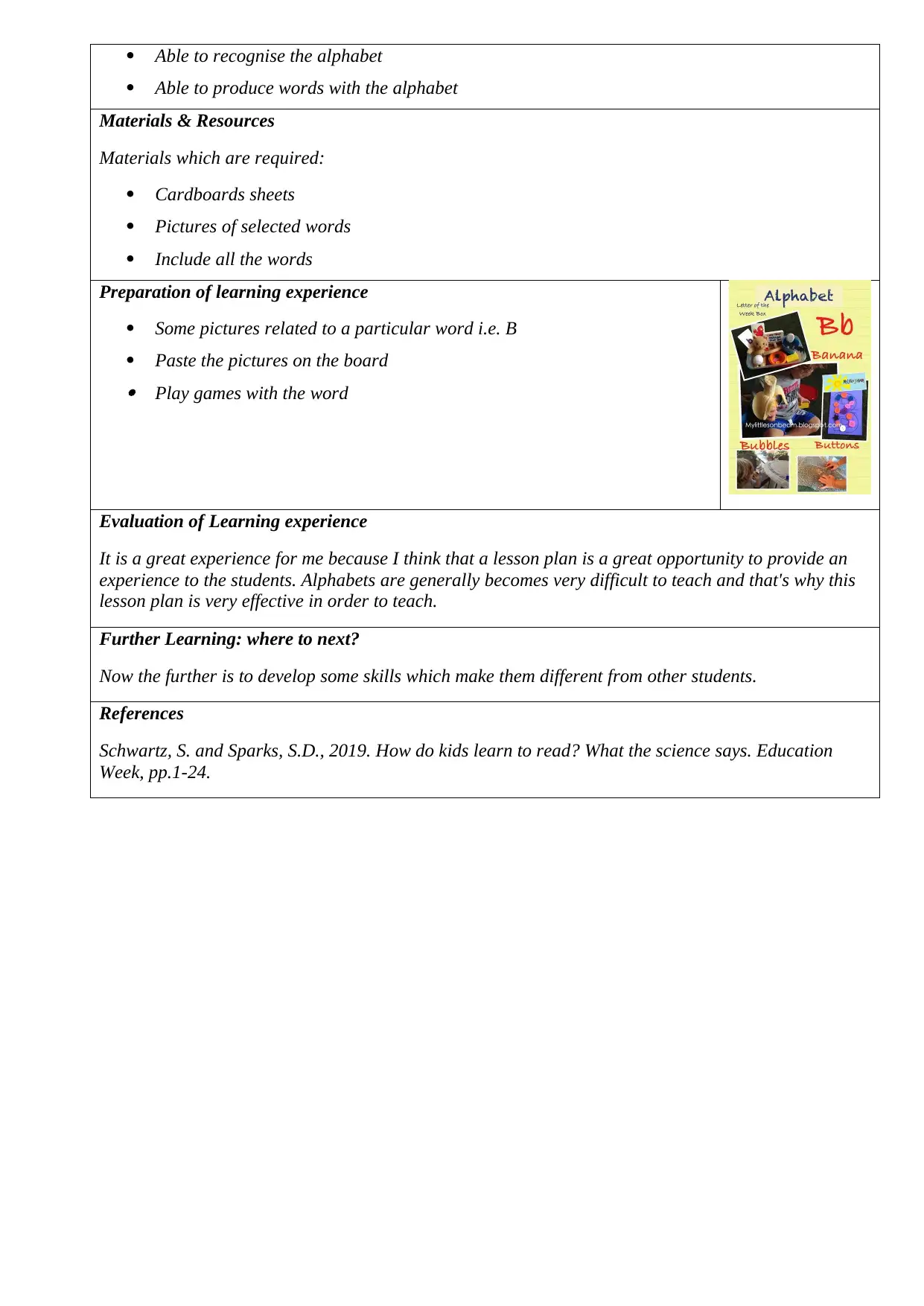
Able to recognise the alphabet
Able to produce words with the alphabet
Materials & Resources
Materials which are required:
Cardboards sheets
Pictures of selected words
Include all the words
Preparation of learning experience
Some pictures related to a particular word i.e. B
Paste the pictures on the board Play games with the word
Evaluation of Learning experience
It is a great experience for me because I think that a lesson plan is a great opportunity to provide an
experience to the students. Alphabets are generally becomes very difficult to teach and that's why this
lesson plan is very effective in order to teach.
Further Learning: where to next?
Now the further is to develop some skills which make them different from other students.
References
Schwartz, S. and Sparks, S.D., 2019. How do kids learn to read? What the science says. Education
Week, pp.1-24.
Able to produce words with the alphabet
Materials & Resources
Materials which are required:
Cardboards sheets
Pictures of selected words
Include all the words
Preparation of learning experience
Some pictures related to a particular word i.e. B
Paste the pictures on the board Play games with the word
Evaluation of Learning experience
It is a great experience for me because I think that a lesson plan is a great opportunity to provide an
experience to the students. Alphabets are generally becomes very difficult to teach and that's why this
lesson plan is very effective in order to teach.
Further Learning: where to next?
Now the further is to develop some skills which make them different from other students.
References
Schwartz, S. and Sparks, S.D., 2019. How do kids learn to read? What the science says. Education
Week, pp.1-24.
1 out of 24
Related Documents
Your All-in-One AI-Powered Toolkit for Academic Success.
+13062052269
info@desklib.com
Available 24*7 on WhatsApp / Email
![[object Object]](/_next/static/media/star-bottom.7253800d.svg)
Unlock your academic potential
© 2024 | Zucol Services PVT LTD | All rights reserved.





